-
AuthorSearch Results
-
December 18, 2021 at 7:05 pm #6246
In reply to: The Elusive Samuel Housley and Other Family Stories
Florence Nightingale Gretton
1881-1927
Florence’s father was Richard Gretton, a baker in Swadlincote, Derbyshire. When Richard married Sarah Orgill in 1861, they lived with her mother, a widow, in Measham, Ashby de la Zouch in Leicestershire. On the 1861 census Sarah’s mother, Elizabeth, is a farmer of two acres.
(Swadlincote and Ashby de la Zouch are on the Derbyshire Leicestershire border and not far from each other. Swadlincote is near to Burton upon Trent which is sometimes in Staffordshire, sometimes in Derbyshire. Newhall, Church Gresley, and Swadlincote are all very close to each other or districts in the same town.)
Ten years later in 1871 Richard and Sarah have their own place in Swadlincote, he is a baker, and they have four children. A fourteen year old apprentice or servant is living with them.
In the Ashby-de-la-Zouch Gazette on 28 February 1880, it was reported that Richard Gretton, baker, of Swadlincote, was charged by Captain Bandys with carrying bread in a cart for sale, the said cart not being provided with scales and weights, according to the requirements of the Act, on the 17th January last.—Defendant pleaded guilty, but urged in extenuation of the offence that in the hurry he had forgotten to put the scales in the cart before his son started.—The Bench took this view of the case, regarding it as an oversight, and fined him one shilling only and costs. This was not his only offence.
In 1883, he was fined twenty shillings, and ten shillings and sixpence costs.
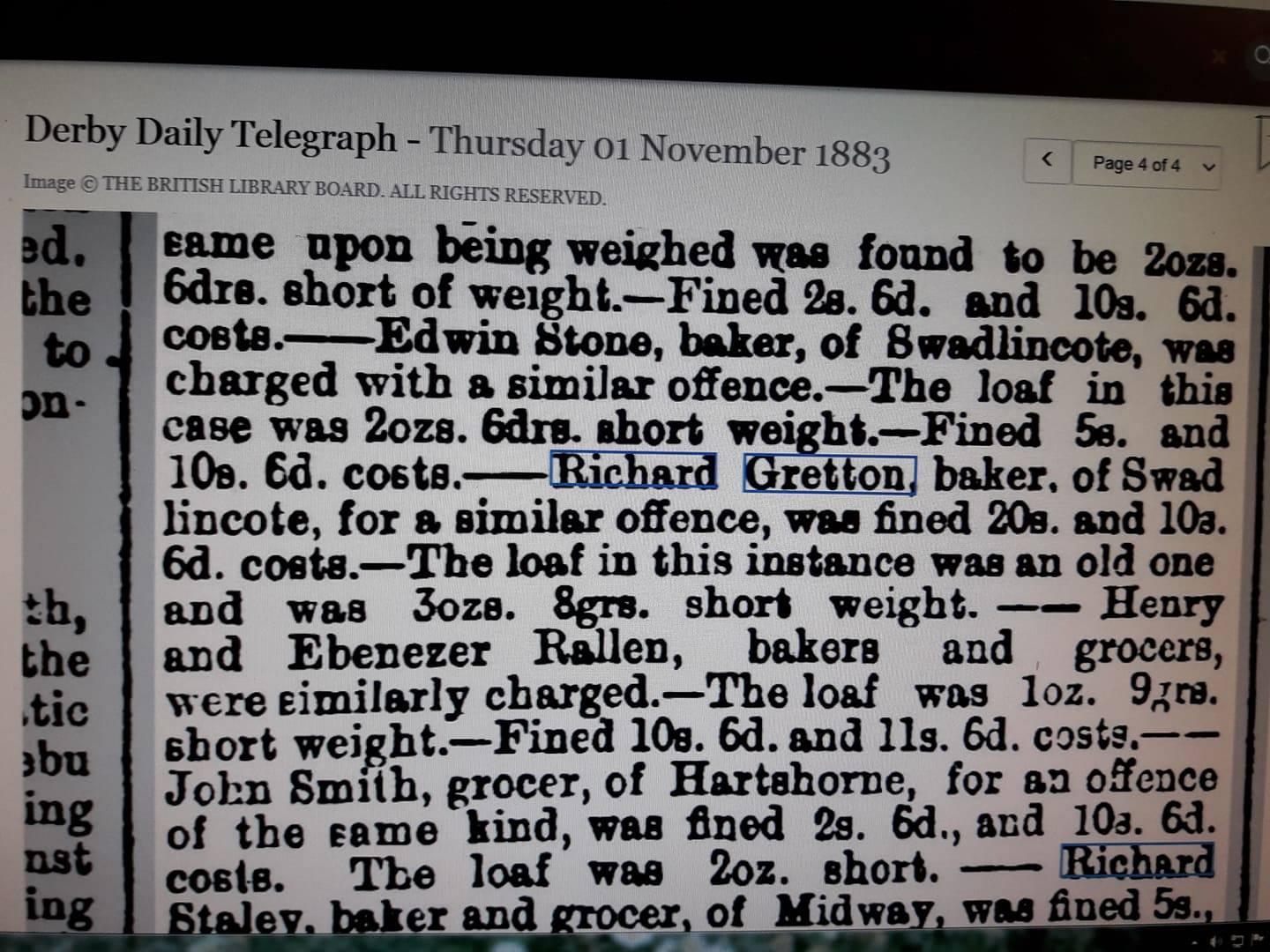
By 1881 they have 4 more children, and Florence Nightingale is the youngest at four months. Richard is 48 by now, and Sarah is 44. Florence’s older brother William is a blacksmith.
Interestingly on the same census page, two doors down Thomas and Selina Warren live at the Stanhope Arms. Richards son John Gretton lives at the pub, a 13 year old servant. Incidentally, I noticed on Thomas and Selena’s marriage register that Richard and Sarah Gretton were the witnesses at the wedding.
Ten years later in 1891, Florence Nightingale and her sister Clara are living with Selina Warren, widow, retired innkeeper, one door down from the Stanhope Arms. Florence is ten, Clara twelve and they are scholars.
Richard and Sarah are still living three doors up on the other side of the Stanhope Arms, with three of their sons. But the two girls lived up the road with the Warren widow!The Stanhope Arms, Swadlincote: it’s possible that the shop with the awning was Richard Gretton’s bakers shop (although not at the time of this later photo).
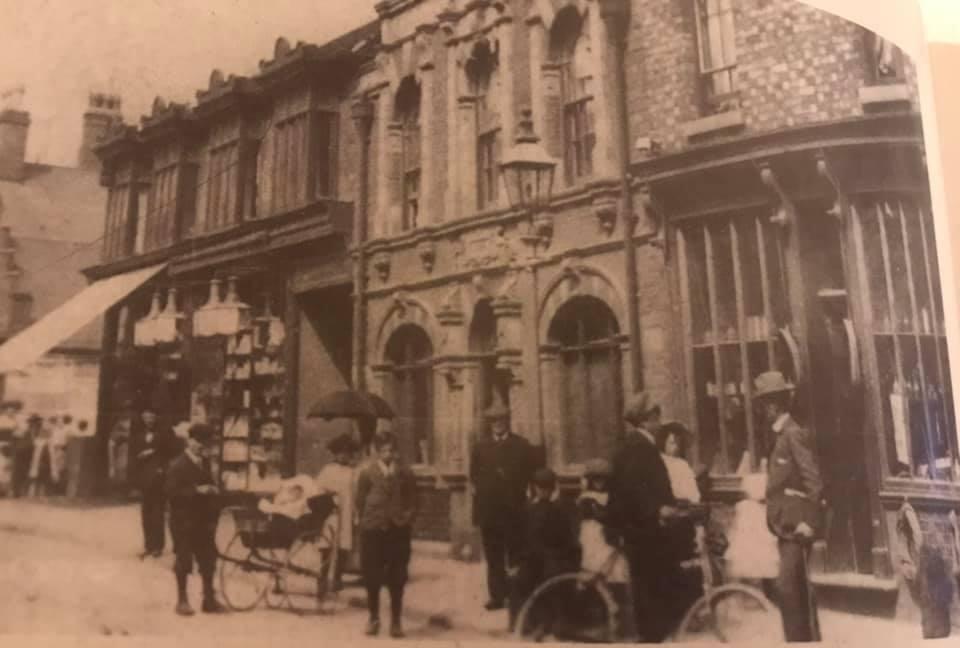
Richard died in 1898, a year before Florence married Samuel Warren.
Sarah is a widowed 60 year old baker on the 1901 census. Her son 26 year old son Alf, also a baker, lives at the same address, as does her 22 year old daughter Clara who is a district nurse.
Clara Gretton and family, photo found online:
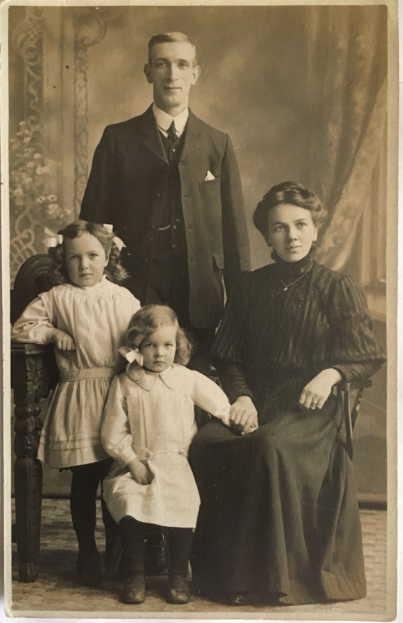
In 1901 Florence Nightingale (who we don’t have a photograph of!) is now married and is Florrie Warren on the census, and she, her husband Samuel, and their one year old daughter Hildred are visitors at the address of Elizabeth (Staley)Warren, 60 year old widow and Samuel’s mother, and Samuel’s 36 year old brother William. Samuel and William are engineers.
Samuel and Florrie had ten children between 1900 and 1925 (and all but two of them used their middle name and not first name: my mother and I had no idea until I found all the records. My grandmother Florence Noreen was known as Nora, which we knew of course, uncle Jack was actually Douglas John, and so on).
Hildred, Clara, Billy, and Nora were born in Swadlincote. Sometime between my grandmother’s birth in 1907 and Kay’s birth in 1911, the family moved to Oldswinford, in Stourbridge. Later they moved to Market Street.
1911 census, Oldswinford, Stourbridge:

Oddly, nobody knew when Florrie Warren died. My mothers cousin Ian Warren researched the Warren family some years ago, while my grandmother was still alive. She contributed family stories and information, but couldn’t remember if her mother died in 1929 or 1927. A recent search of records confirmed that it was the 12th November 1927.
She was 46 years old. We were curious to know how she died, so my mother ordered a paper copy of her death certificate. It said she died at 31 Market Street, Stourbridge at the age of 47. Clara May Warren, her daughter, was in attendance. Her husband Samuel Warren was a motor mechanic. The Post mortem was by Percival Evans, coroner for Worcestershire, who clarified the cause of death as vascular disease of the heart. There was no inquest. The death was registered on 15 Nov 1927.
I looked for a photo of 31 Market Street in Stourbridge, and was astonished to see that it was the house next door to one I lived in breifly in the 1980s. We didn’t know that the Warren’s lived in Market Street until we started searching the records.
Market Street, Stourbridge. I lived in the one on the corner on the far right, my great grandmother died in the one next door.
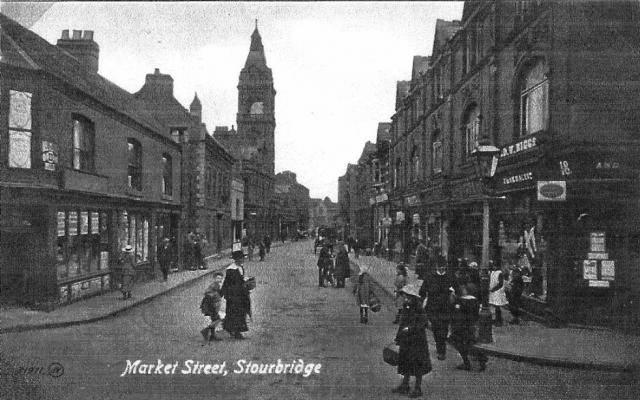
I found some hitherto unknown emigrants in the family. Florence Nightingale Grettons eldest brother William 1861-1940 stayed in Swadlincote. John Orgill Gretton born in 1868 moved to Trenton New Jersey USA in 1888, married in 1892 and died in 1949 in USA. Michael Thomas born in 1870 married in New York in 1893 and died in Trenton in 1940. Alfred born 1875 stayed in Swadlincote. Charles Herbert born 1876 married locally and then moved to Australia in 1912, and died in Victoria in 1954. Clara Elizabeth was a district nurse, married locally and died at the age of 99.
December 18, 2021 at 12:59 pm #6243In reply to: The Elusive Samuel Housley and Other Family Stories
William Housley’s Will and the Court Case
William Housley died in 1848, but his widow Ellen didn’t die until 1872. The court case was in 1873. Details about the court case are archived at the National Archives at Kew, in London, but are not available online. They can be viewed in person, but that hasn’t been possible thus far. However, there are a great many references to it in the letters.
William Housley’s first wife was Mary Carrington 1787-1813. They had three children, Mary Anne, Elizabeth and William. When Mary died, William married Mary’s sister Ellen, not in their own parish church at Smalley but in Ashbourne. Although not uncommon for a widower to marry a deceased wife’s sister, it wasn’t legal. This point is mentioned in one of the letters.
One of the pages of William Housley’s will:
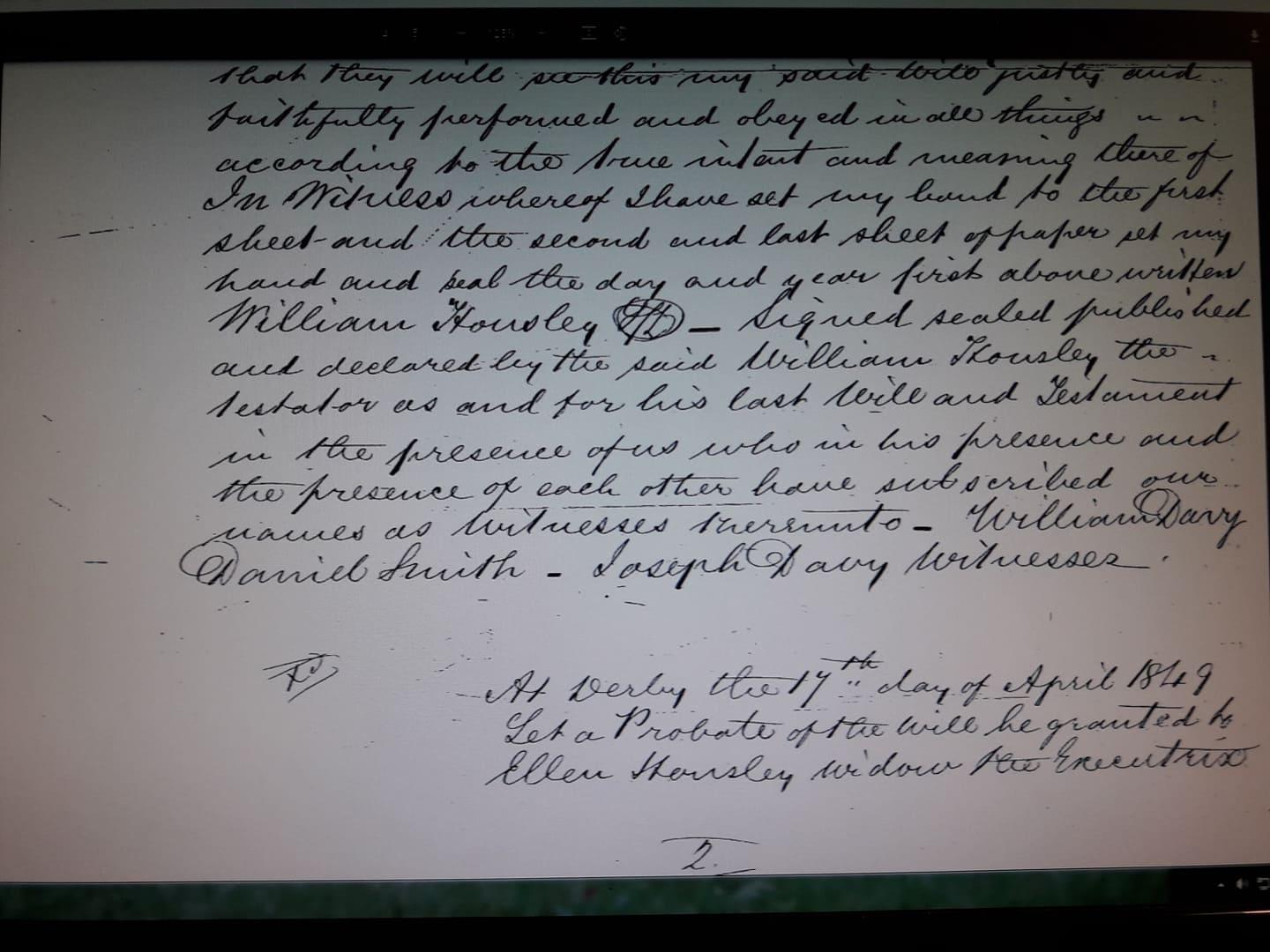
An excerpt from Barbara Housley’s Narrative on the Letters:
A comment in a letter from Joseph (August 6, 1873) indicated that William was married twice and that his wives were sisters: “What do you think that I believe that Mary Ann is trying to make our father’s will of no account as she says that my father’s marriage with our mother was not lawful he marrying two sisters. What do you think of her? I have heard my mother say something about paying a fine at the time of the marriage to make it legal.” Markwell and Saul in The A-Z Guide to Tracing Ancestors in Britain explain that marriage to a deceased wife’s sister was not permissible under Canon law as the relationship was within the prohibited degrees. However, such marriages did take place–usually well away from the couple’s home area. Up to 1835 such marriages were not void but were voidable by legal action. Few such actions were instituted but the risk was always there.
Joseph wrote that when Emma was married, Ellen “broke up the comfortable home and the things went to Derby and she went to live with them but Derby didn’t agree with her so she left again leaving her things behind and came to live with John in the new house where she died.” Ellen was listed with John’s household in the 1871 census.
In May 1872, the Ilkeston Pioneer carried this notice: “Mr. Hopkins will sell by auction on Saturday next the eleventh of May 1872 the whole of the useful furniture, sewing machine, etc. nearly new on the premises of the late Mrs. Housley at Smalley near Heanor in the county of Derby. Sale at one o’clock in the afternoon.”There were hard feelings between Mary Ann and Ellen and her children. Anne wrote: “If you remember we were not very friendly when you left. They never came and nothing was too bad for Mary Ann to say of Mother and me, but when Robert died Mother sent for her to the funeral but she did not think well to come so we took no more notice. She would not allow her children to come either.”
Mary Ann was still living in May 1872. Joseph implied that she and her brother, Will “intend making a bit of bother about the settlement of the bit of property” left by their mother. The 1871 census listed Mary Ann’s occupation as “income from houses.”In July 1872, Joseph introduced Ruth’s husband: “No doubt he is a bad lot. He is one of the Heath’s of Stanley Common a miller and he lives at Smalley Mill” (Ruth Heath was Mary Anne Housley’s daughter)
In 1873 Joseph wrote, “He is nothing but a land shark both Heath and his wife and his wife is the worst of the two. You will think these is hard words but they are true dear brother.” The solicitor, Abraham John Flint, was not at all pleased with Heath’s obstruction of the settlement of the estate. He wrote on June 30, 1873: “Heath agreed at first and then because I would not pay his expenses he refused and has since instructed another solicitor for his wife and Mrs. Weston who have been opposing us to the utmost. I am concerned for all parties interested except these two….The judge severely censured Heath for his conduct and wanted to make an order for sale there and then but Heath’s council would not consent….” In June 1875, the solicitor wrote: “Heath bid for the property but it fetched more money than he could give for it. He has been rather quieter lately.”In May 1872, Joseph wrote: “For what do you think, John has sold his share and he has acted very bad since his wife died and at the same time he sold all his furniture. You may guess I have never seen him but once since poor mother’s funeral and he is gone now no one knows where.”
In 1876, the solicitor wrote to George: “Have you heard of John Housley? He is entitled to Robert’s share and I want him to claim it.”
Anne intended that one third of the inheritance coming to her from her father and her grandfather, William Carrington, be divided between her four nieces: Sam’s three daughters and John’s daughter Elizabeth.
In the same letter (December 15, 1872), Joseph wrote:
“I think we have now found all out now that is concerned in the matter for there was only Sam that we did not know his whereabouts but I was informed a week ago that he is dead–died about three years ago in Birmingham Union. Poor Sam. He ought to have come to a better end than that”However, Samuel was still alive was on the 1871 census in Henley in Arden, and no record of his death can be found. Samuel’s brother in law said he was dead: we do not know why he lied, or perhaps the brothers were lying to keep his share, or another possibility is that Samuel himself told his brother in law to tell them that he was dead. I am inclined to think it was the latter.
Excerpts from Barbara Housley’s Narrative on the Letters continued:
Charles went to Australia in 1851, and was last heard from in January 1853. According to the solicitor, who wrote to George on June 3, 1874, Charles had received advances on the settlement of their parent’s estate. “Your promissory note with the two signed by your brother Charles for 20 pounds he received from his father and 20 pounds he received from his mother are now in the possession of the court.”
In December 1872, Joseph wrote: “I’m told that Charles two daughters has wrote to Smalley post office making inquiries about his share….” In January 1876, the solicitor wrote: “Charles Housley’s children have claimed their father’s share.”
In the Adelaide Observer 28 Aug 1875
HOUSLEY – wanted information
as to the Death, Will, or Intestacy, and
Children of Charles Housley, formerly of
Smalley, Derbyshire, England, who died at
Geelong or Creewick Creek Diggings, Victoria
August, 1855. His children will hear of something to their advantage by communicating with
Mr. A J. Flint, solicitor, Derby, England.
June 16,1875.The Diggers & Diggings of Victoria in 1855. Drawn on Stone by S.T. Gill:
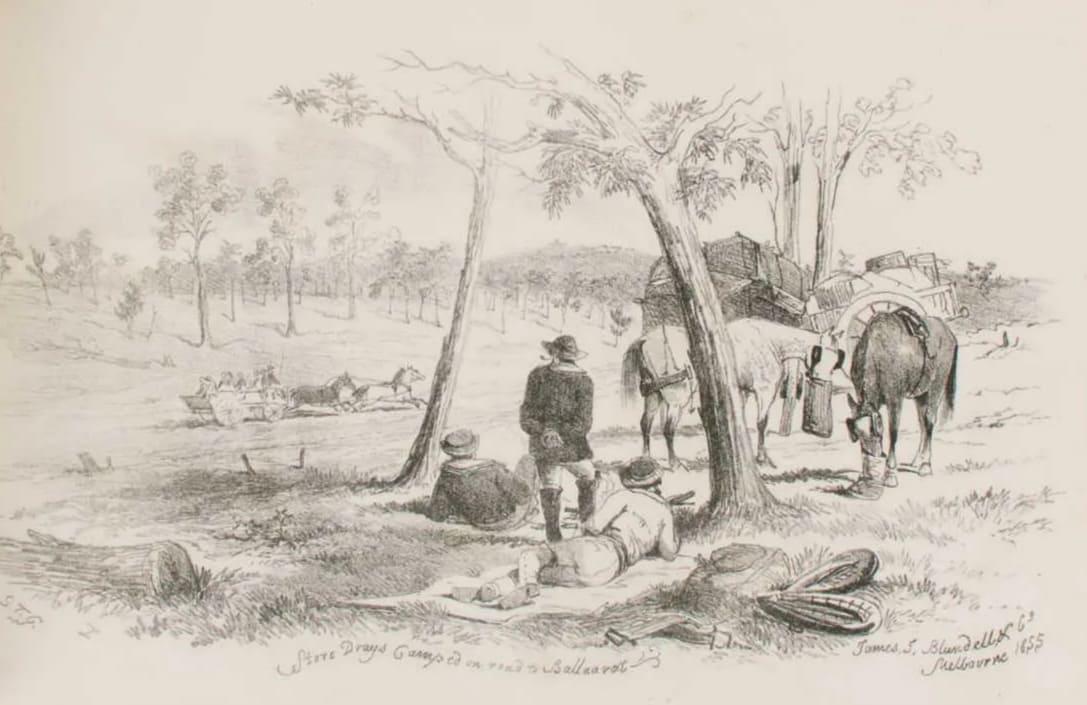
The court case:
Kerry v Housley.
Documents: Bill, demurrer.
Plaintiffs: Samuel Kerry and Joseph Housley.
Defendants: William Housley, Joseph Housley (deleted), Edwin Welch Harvey, Eleanor Harvey (deleted), Ernest Harvey infant, William Stafford, Elizabeth Stafford his wife, Mary Ann Housley, George Purdy and Catherine Purdy his wife, Elizabeth Housley, Mary Ann Weston widow and William Heath and Ruth Heath his wife (deleted).
Provincial solicitor employed in Derbyshire.
Date: 1873From the Narrative on the Letters:
The solicitor wrote on May 23, 1874: “Lately I have not written because I was not certain of your address and because I doubted I had much interesting news to tell you.” Later, Joseph wrote concerning the problems settling the estate, “You see dear brother there is only me here on our side and I cannot do much. I wish you were here to help me a bit and if you think of going for another summer trip this turn you might as well run over here.”
In March 1873, Joseph wrote: “You ask me what I think of you coming to England. I think as you have given the trustee power to sign for you I think you could do no good but I should like to see you once again for all that. I can’t say whether there would be anything amiss if you did come as you say it would be throwing good money after bad.”
In September 1872 Joseph wrote; “My wife is anxious to come. I hope it will suit her health for she is not over strong.” Elsewhere Joseph wrote that Harriet was “middling sometimes. She is subject to sick headaches. It knocks her up completely when they come on.” In December 1872 Joseph wrote, “Now dear brother about us coming to America you know we shall have to wait until this affair is settled and if it is not settled and thrown into Chancery I’m afraid we shall have to stay in England for I shall never be able to save money enough to bring me out and my family but I hope of better things.”
On July 19, 1875 Abraham Flint (the solicitor) wrote: “Joseph Housley has removed from Smalley and is working on some new foundry buildings at Little Chester near Derby. He lives at a village called Little Eaton near Derby. If you address your letter to him as Joseph Housley, carpenter, Little Eaton near Derby that will no doubt find him.”In his last letter (February 11, 1874), Joseph sounded very discouraged and wrote that Harriet’s parents were very poorly and both had been “in bed for a long time.” In addition, Harriet and the children had been ill.
The move to Little Eaton may indicate that Joseph received his settlement because in August, 1873, he wrote: “I think this is bad news enough and bad luck too, but I have had little else since I came to live at Kiddsley cottages but perhaps it is all for the best if one could only think so. I have begun to think there will be no chance for us coming over to you for I am afraid there will not be so much left as will bring us out without it is settled very shortly but I don’t intend leaving this house until it is settled either one way or the other. ”Joseph’s letters were much concerned with the settling of their mother’s estate. In 1854, Anne wrote, “As for my mother coming (to America) I think not at all likely. She is tied here with her property.” A solicitor, Abraham John Flint of 42 Full Street Derby, was engaged by John following the death of their mother. On June 30, 1873 the solicitor wrote: “Dear sir, On the death of your mother I was consulted by your brother John. I acted for him with reference to the sale and division of your father’s property at Smalley. Mr. Kerry was very unwilling to act as trustee being over 73 years of age but owing to the will being a badly drawn one we could not appoint another trustee in his place nor could the property be sold without a decree of chancery. Therefore Mr. Kerry consented and after a great deal of trouble with Heath who has opposed us all throughout whenever matters did not suit him, we found the title deeds and offered the property for sale by public auction on the 15th of July last. Heath could not find his purchase money without mortaging his property the solicitor which the mortgagee employed refused to accept Mr. Kerry’s title and owing to another defect in the will we could not compel them.”
In July 1872, Joseph wrote, “I do not know whether you can remember who the trustee was to my father’s will. It was Thomas Watson and Samuel Kerry of Smalley Green. Mr. Watson is dead (died a fortnight before mother) so Mr. Kerry has had to manage the affair.”
On Dec. 15, 1972, Joseph wrote, “Now about this property affair. It seems as far off of being settled as ever it was….” and in the following March wrote: “I think we are as far off as ever and farther I think.”
Concerning the property which was auctioned on July 15, 1872 and brought 700 pounds, Joseph wrote: “It was sold in five lots for building land and this man Heath bought up four lots–that is the big house, the croft and the cottages. The croft was made into two lots besides the piece belonging to the big house and the cottages and gardens was another lot and the little intake was another. William Richardson bought that.” Elsewhere Richardson’s purchase was described as “the little croft against Smith’s lane.” Smith’s Lane was probably named for their neighbor Daniel Smith, Mrs. Davy’s father.
But in December 1872, Joseph wrote that they had not received any money because “Mr. Heath is raising all kinds of objections to the will–something being worded wrong in the will.” In March 1873, Joseph “clarified” matters in this way: “His objection was that one trustee could not convey the property that his signature was not guarantee sufficient as it states in the will that both trustees has to sign the conveyance hence this bother.”
Joseph indicated that six shares were to come out of the 700 pounds besides Will’s 20 pounds. Children were to come in for the parents shares if dead. The solicitor wrote in 1873, “This of course refers to the Kidsley property in which you take a one seventh share and which if the property sells well may realize you about 60-80 pounds.” In March 1873 Joseph wrote: “You have an equal share with the rest in both lots of property, but I am afraid there will be but very little for any of us.”The other “lot of property” was “property in Smalley left under another will.” On July 17, 1872, Joseph wrote: “It was left by my grandfather Carrington and Uncle Richard is trustee. He seems very backward in bringing the property to a sale but I saw him and told him that I for one expect him to proceed with it.” George seemed to have difficulty understanding that there were two pieces of property so Joseph explained further: “It was left by my grandfather Carrington not by our father and Uncle Richard is the trustee for it but the will does not give him power to sell without the signatures of the parties concerned.” In June 1873 the solicitor Abraham John Flint asked: “Nothing has been done about the other property at Smalley at present. It wants attention and the other parties have asked me to attend to it. Do you authorize me to see to it for you as well?”
After Ellen’s death, the rent was divided between Joseph, Will, Mary Ann and Mr. Heath who bought John’s share and was married to Mary Ann’s daughter, Ruth. Joseph said that Mr. Heath paid 40 pounds for John’s share and that John had drawn 110 pounds in advance. The solicitor said Heath said he paid 60. The solicitor said that Heath was trying to buy the shares of those at home to get control of the property and would have defied the absent ones to get anything.
In September 1872 Joseph wrote that the lawyer said the trustee cannot sell the property at the bottom of Smalley without the signatures of all parties concerned in it and it will have to go through chancery court which will be a great expense. He advised Joseph to sell his share and Joseph advised George to do the same.George sent a “portrait” so that it could be established that it was really him–still living and due a share. Joseph wrote (July 1872): “the trustee was quite willing to (acknowledge you) for the portrait I think is a very good one.” Several letters later in response to an inquiry from George, Joseph wrote: “The trustee recognized you in a minute…I have not shown it to Mary Ann for we are not on good terms….Parties that I have shown it to own you again but they say it is a deal like John. It is something like him, but I think is more like myself.”
In September 1872 Joseph wrote that the lawyer required all of their ages and they would have to pay “succession duty”. Joseph requested that George send a list of birth dates.On May 23, 1874, the solicitor wrote: “I have been offered 240 pounds for the three cottages and the little house. They sold for 200 pounds at the last sale and then I was offered 700 pounds for the whole lot except Richardson’s Heanor piece for which he is still willing to give 58 pounds. Thus you see that the value of the estate has very materially increased since the last sale so that this delay has been beneficial to your interests than other-wise. Coal has become much dearer and they suppose there is coal under this estate. There are many enquiries about it and I believe it will realize 800 pounds or more which increase will more than cover all expenses.” Eventually the solicitor wrote that the property had been sold for 916 pounds and George would take a one-ninth share.
January 14, 1876: “I am very sorry to hear of your lameness and illness but I trust that you are now better. This matter as I informed you had to stand over until December since when all the costs and expenses have been taxed and passed by the court and I am expecting to receive the order for these this next week, then we have to pay the legacy duty and them divide the residue which I doubt won’t come to very much amongst so many of you. But you will hear from me towards the end of the month or early next month when I shall have to send you the papers to sign for your share. I can’t tell you how much it will be at present as I shall have to deduct your share with the others of the first sale made of the property before it went to court.
Wishing you a Happy New Year, I am Dear Sir, Yours truly
Abram J. Flint”September 15, 1876 (the last letter)
“I duly received your power of attorney which appears to have been properly executed on Thursday last and I sent it on to my London agent, Mr. Henry Lyvell, who happens just now to be away for his annual vacation and will not return for 14 or 20 days and as his signature is required by the Paymaster General before he will pay out your share, it must consequently stand over and await his return home. It shall however receive immediate attention as soon as he returns and I hope to be able to send your checque for the balance very shortly.”1874 in chancery:
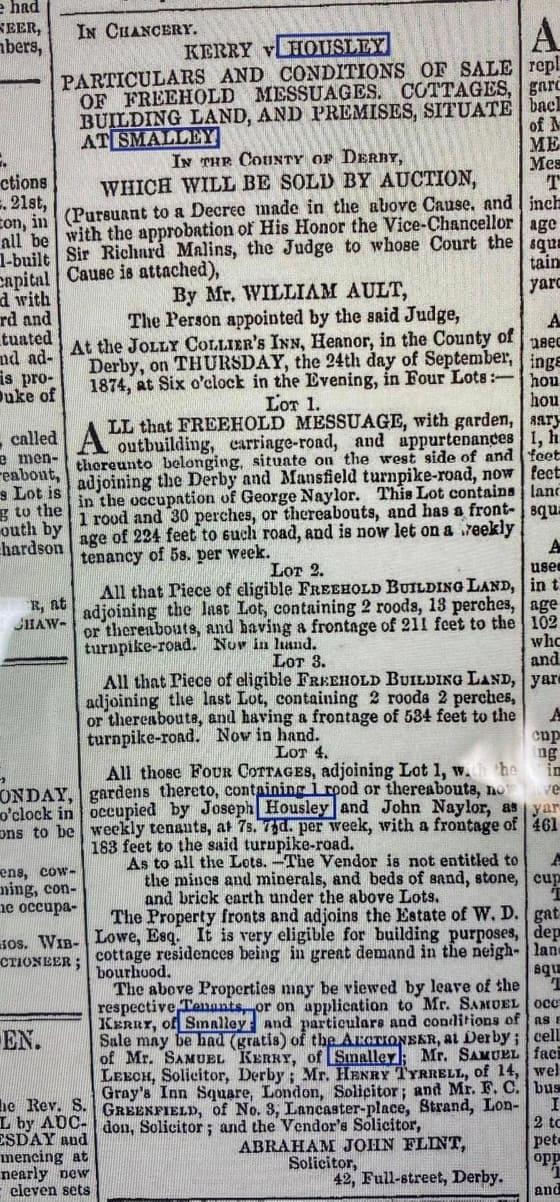 December 15, 2021 at 1:16 pm #6237
December 15, 2021 at 1:16 pm #6237In reply to: The Elusive Samuel Housley and Other Family Stories
Murder At The Bennistons
We don’t know exactly what happened immediately after the death of Catherine Housley’s mother in 1849, but by 1850 the two older daughters Elizabeth and Mary Anne were inmates in Belper Workhouse. Catherine was just six weeks old, so presumably she was with a wet nurse, possibly even prior to her mothers death. By 1851, according to the census, she was living in Heanor, a small town near to Smalley, with John Benniston, a framework knitter, and his family. Framework knitters (abbreviated to FWK should you happen to see it on a census) rented a large loom and made stockings and everyone in the family helped. Often the occupation of other household members would be “seamer”: they would stitch the stocking seams together. Catherine was still living with the Bennistons ten years later in 1861.

I read some chapters of a thesis on the south Derbyshire poor in the 1800s and found some illuminating information about indentured apprenticeship of children especially if one parent died. It was not at all uncommon, and framework knitters in particular often had indentured apprentices. It was a way to ensure the child was fed and learned a skill. Children commonly worked from the age of ten or 12 anyway. They were usually placed walking distance of the family home and maintained contact. The indenture could be paid by the parish poor fund, which cost them slightly less than sending them to the poorhouse, and could be paid off by a parent if circumstances improved to release the child from the apprenticeship.
A child who was an indentured apprentice would continue a normal life after the term of apprenticeship, usually still in contact with family locally.I found a newspaper article titled “Child Murder at Heanor” dated 1858.
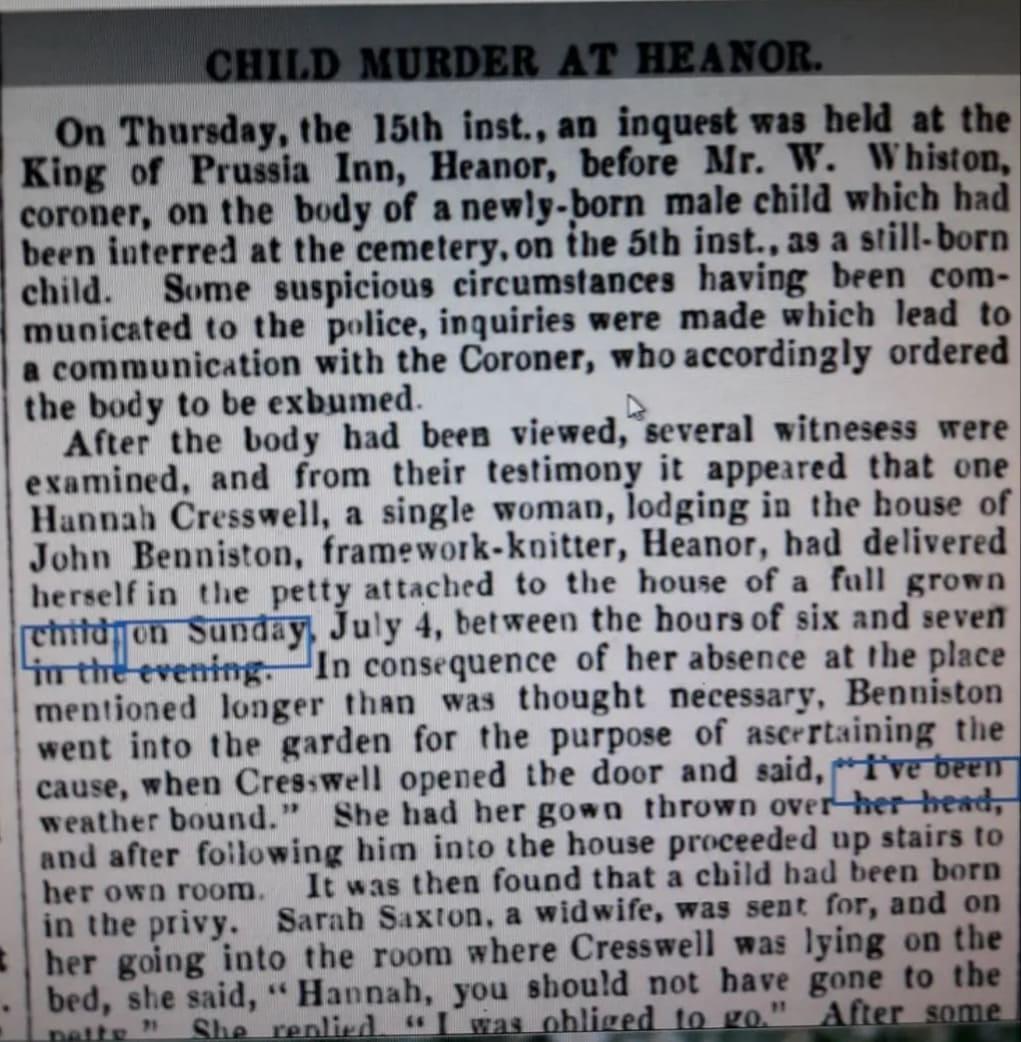
A 23 year old lodger at the Bennistons, Hannah Cresswell, apparently murdered a new born baby that she gave birth to in the privy, which the midwife took away and had buried as a still birth. The baby was exhumed after an anonymous tip off from a neighbour, citing that it was the 4th such incident. Catherine Housley would have been nine years old at the time.
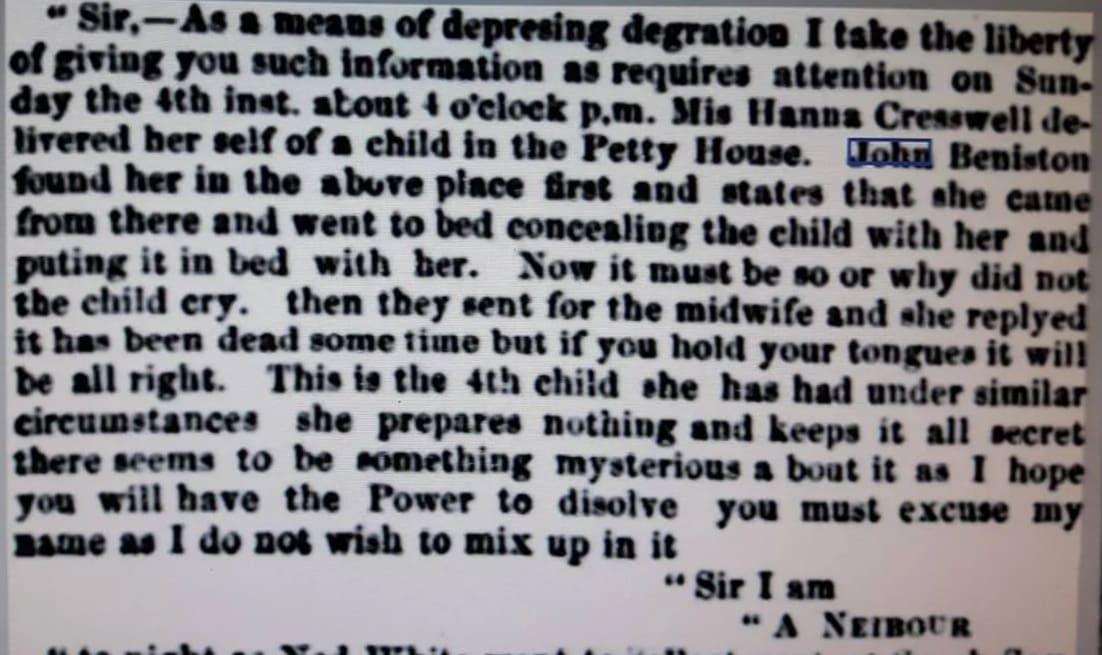
Subsequent newspaper articles indicate that the case was thrown out, despite the doctors evidence that the baby had been beaten to death.
In July 1858 the inquest was held in the King of Prussia, on the Hannah Cresswell baby murder at the Bennistons.
The King of Prussia, Heanor, in 1860:
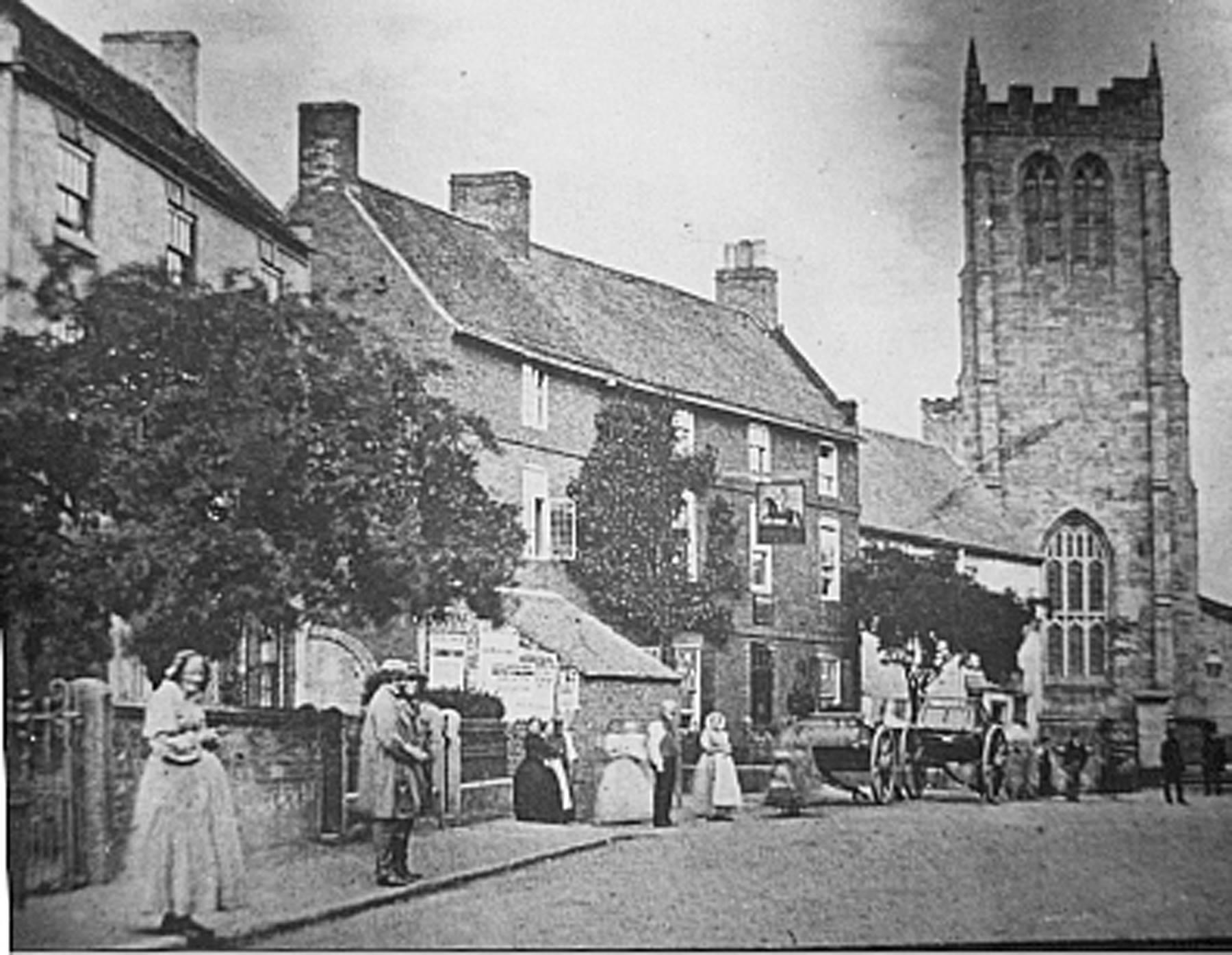 December 15, 2021 at 9:34 am #6236
December 15, 2021 at 9:34 am #6236In reply to: The Elusive Samuel Housley and Other Family Stories
The Liverpool Fires
Catherine Housley had two older sisters, Elizabeth 1845-1883 and Mary Anne 1846-1935. Both Elizabeth and Mary Anne grew up in the Belper workhouse after their mother died, and their father was jailed for failing to maintain his three children. Mary Anne married Samuel Gilman and they had a grocers shop in Buxton. Elizabeth married in Liverpool in 1873.
What was she doing in Liverpool? How did she meet William George Stafford?
According to the census, Elizabeth Housley was in Belper workhouse in 1851. In 1861, aged 16, she was a servant in the household of Peter Lyon, a baker in Derby St Peters. We noticed that the Lyon’s were friends of the family and were mentioned in the letters to George in Pennsylvania.
No record of Elizabeth can be found on the 1871 census, but in 1872 the birth and death was registered of Elizabeth and William’s child, Elizabeth Jane Stafford. The parents are registered as William and Elizabeth Stafford, although they were not yet married. William’s occupation is a “refiner”.
In April, 1873, a Fatal Fire is reported in the Liverpool Mercury. Fearful Termination of a Saturday Night Debauch. Seven Persons Burnt To Death. Interesting to note in the article that “the middle room being let off to a coloured man named William Stafford and his wife”.
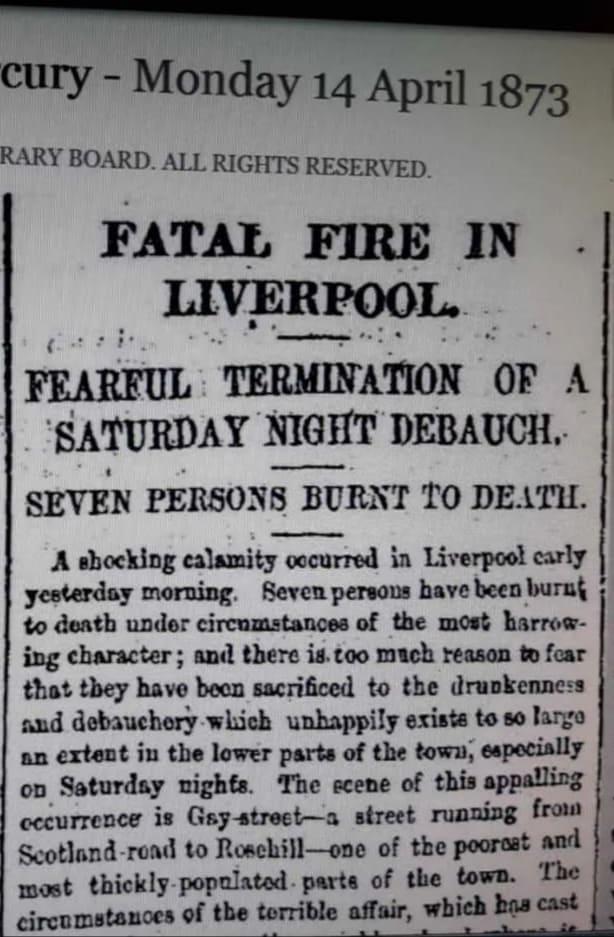
We had noted on the census that William Stafford place of birth was “Africa, British subject” but it had not occurred to us that he was “coloured”. A register of birth has not yet been found for William and it is not known where in Africa he was born.
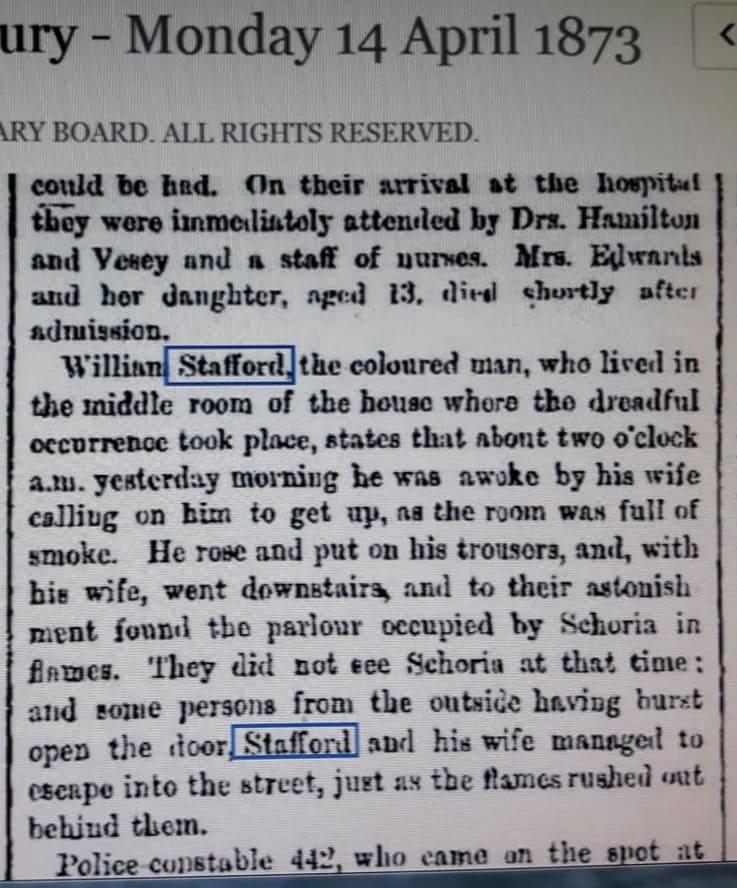
Elizabeth and William survived the fire on Gay Street, and were still living on Gay Street in October 1873 when they got married.
William’s occupation on the marriage register is sugar refiner, and his father is Peter Stafford, farmer. Elizabeth’s father is Samuel Housley, plumber. It does not say Samuel Housley deceased, so perhaps we can assume that Samuel is still alive in 1873.
Eliza Florence Stafford, their second daughter, was born in 1876.
William’s occupation on the 1881 census is “fireman”, in his case, a fire stoker at the sugar refinery, an unpleasant and dangerous job for which they were paid slightly more. William, Elizabeth and Eliza were living in Byrom Terrace.
Byrom Terrace, Liverpool, in 1933
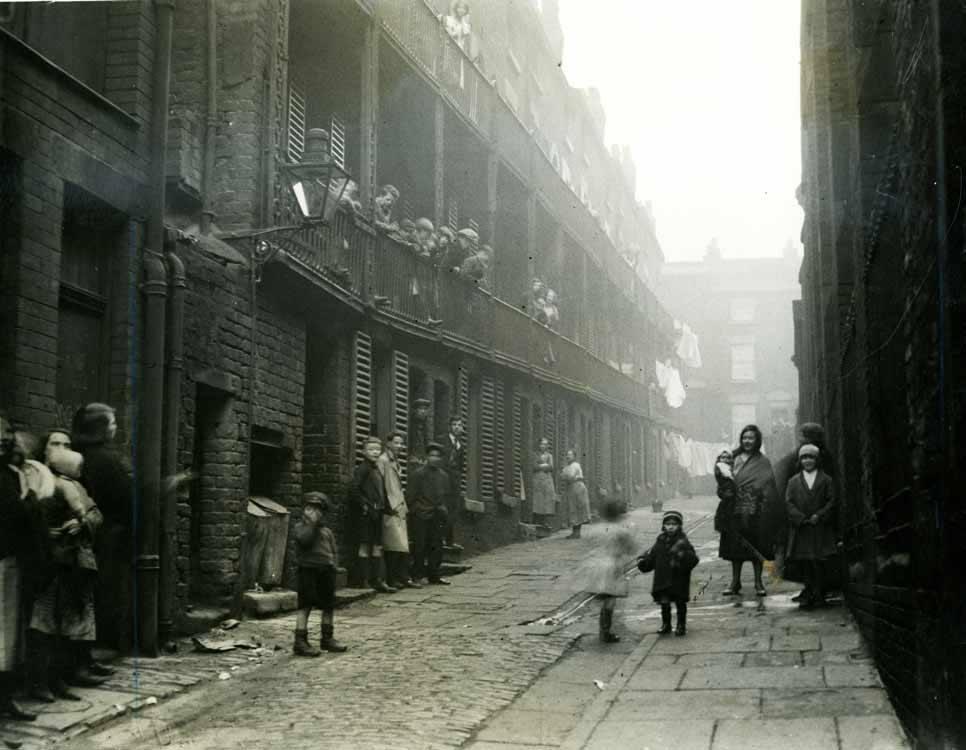
Elizabeth died of heart problems in 1883, when Eliza was six years old, and in 1891 her father died, scalded to death in a tragic accident at the sugar refinery.

Eliza, aged 15, was living as an inmate at the Walton on the Hill Institution in 1891. It’s not clear when she was admitted to the workhouse, perhaps after her mother died in 1883.
In 1901 Eliza Florence Stafford is a 24 year old live in laundrymaid, according to the census, living in West Derby (a part of Liverpool, and not actually in Derby). On the 1911 census there is a Florence Stafford listed as an unnmarried laundress, with a daughter called Florence. In 1901 census she was a laundrymaid in West Derby, Liverpool, and the daughter Florence Stafford was born in 1904 West Derby. It’s likely that this is Eliza Florence, but nothing further has been found so far.
The questions remaining are the location of William’s birth, the name of his mother and his family background, what happened to Eliza and her daughter after 1911, and how did Elizabeth meet William in the first place.
William Stafford was a seaman prior to working in the sugar refinery, and he appears on several ship’s crew lists. Nothing so far has indicated where he might have been born, or where his father came from.
Some months after finding the newspaper article about the fire on Gay Street, I saw an unusual request for information on the Liverpool genealogy group. Someone asked if anyone knew of a fire in Liverpool in the 1870’s. She had watched a programme about children recalling past lives, in this case a memory of a fire. The child recalled pushing her sister into a burning straw mattress by accident, as she attempted to save her from a falling beam. I watched the episode in question hoping for more information to confirm if this was the same fire, but details were scant and it’s impossible to say for sure.
December 13, 2021 at 10:09 am #6219Topic: The Elusive Samuel Housley and Other Family Stories
in forum TP’s Family BooksThe following stories started with a single question.
Who was Catherine Housley’s mother?
But one question leads to another, and another, and so this book will never be finished. This is the first in a collection of stories of a family history research project, not a complete family history. There will always be more questions and more searches, and each new find presents more questions.
A list of names and dates is only moderately interesting, and doesn’t mean much unless you get to know the characters along the way. For example, a cousin on my fathers side has already done a great deal of thorough and accurate family research. I copied one branch of the family onto my tree, going back to the 1500’s, but lost interest in it after about an hour or so, because I didn’t feel I knew any of the individuals.
Parish registers, the census every ten years, birth, death and marriage certificates can tell you so much, but they can’t tell you why. They don’t tell you why parents chose the names they did for their children, or why they moved, or why they married in another town. They don’t tell you why a person lived in another household, or for how long. The census every ten years doesn’t tell you what people were doing in the intervening years, and in the case of the UK and the hundred year privacy rule, we can’t even use those for the past century. The first census was in 1831 in England, prior to that all we have are parish registers. An astonishing amount of them have survived and have been transcribed and are one way or another available to see, both transcriptions and microfiche images. Not all of them survived, however. Sometimes the writing has faded to white, sometimes pages are missing, and in some case the entire register is lost or damaged.
Sometimes if you are lucky, you may find mention of an ancestor in an obscure little local history book or a journal or diary. Wills, court cases, and newspaper archives often provide interesting information. Town memories and history groups on social media are another excellent source of information, from old photographs of the area, old maps, local history, and of course, distantly related relatives still living in the area. Local history societies can be useful, and some if not all are very helpful.
If you’re very lucky indeed, you might find a distant relative in another country whose grandparents saved and transcribed bundles of old letters found in the attic, from the family in England to the brother who emigrated, written in the 1800s. More on this later, as it merits its own chapter as the most exciting find so far.
The social history of the time and place is important and provides many clues as to why people moved and why the family professions and occupations changed over generations. The Enclosures Act and the Industrial Revolution in England created difficulties for rural farmers, factories replaced cottage industries, and the sons of land owning farmers became shop keepers and miners in the local towns. For the most part (at least in my own research) people didn’t move around much unless there was a reason. There are no reasons mentioned in the various registers, records and documents, but with a little reading of social history you can sometimes make a good guess. Samuel Housley, for example, a plumber, probably moved from rural Derbyshire to urban Wolverhampton, when there was a big project to install indoor plumbing to areas of the city in the early 1800s. Derbyshire nailmakers were offered a job and a house if they moved to Wolverhampton a generation earlier.
Occasionally a couple would marry in another parish, although usually they married in their own. Again, there was often a reason. William Housley and Ellen Carrington married in Ashbourne, not in Smalley. In this case, William’s first wife was Mary Carrington, Ellen’s sister. It was not uncommon for a man to marry a deceased wife’s sister, but it wasn’t strictly speaking legal. This caused some problems later when William died, as the children of the first wife contested the will, on the grounds of the second marriage being illegal.
Needless to say, there are always questions remaining, and often a fresh pair of eyes can help find a vital piece of information that has escaped you. In one case, I’d been looking for the death of a widow, Mary Anne Gilman, and had failed to notice that she remarried at a late age. Her death was easy to find, once I searched for it with her second husbands name.
This brings me to the topic of maternal family lines. One tends to think of their lineage with the focus on paternal surnames, but very quickly the number of surnames increases, and all of the maternal lines are directly related as much as the paternal name. This is of course obvious, if you start from the beginning with yourself and work back. In other words, there is not much point in simply looking for your fathers name hundreds of years ago because there are hundreds of other names that are equally your own family ancestors. And in my case, although not intentionally, I’ve investigated far more maternal lines than paternal.
This book, which I hope will be the first of several, will concentrate on my mothers family: The story so far that started with the portrait of Catherine Housley’s mother.
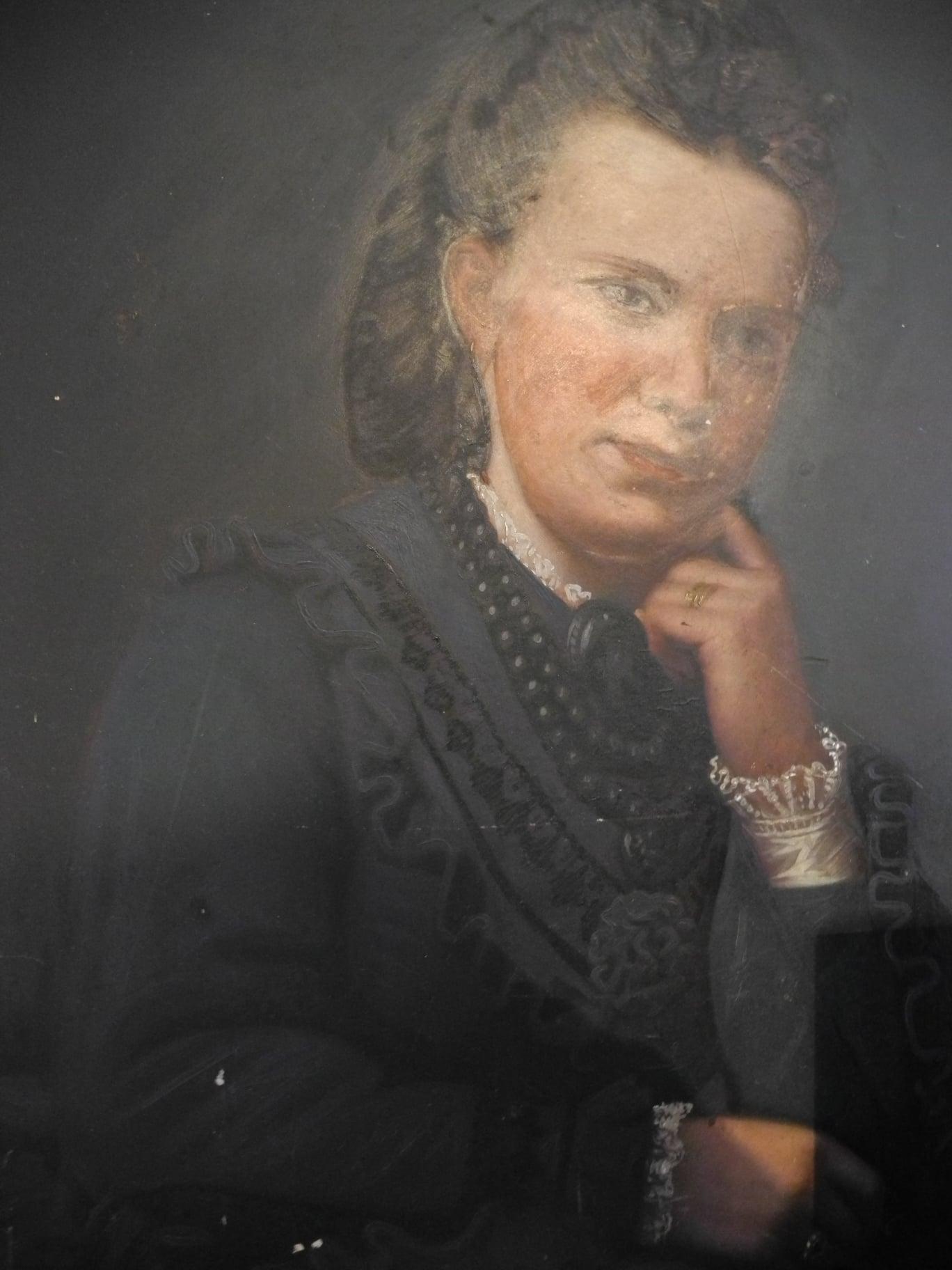
This painting, now in my mothers house, used to hang over the piano in the home of her grandparents. It says on the back “Catherine Housley’s mother, Smalley”.
The portrait of Catherine Housley’s mother can be seen above the piano. Back row Ronald Marshall, my grandfathers brother, William Marshall, my great grandfather, Mary Ann Gilman Purdy Marshall in the middle, my great grandmother, with her daughters Dorothy on the left and Phyllis on the right, at the Marshall’s house on Love Lane in Stourbridge.
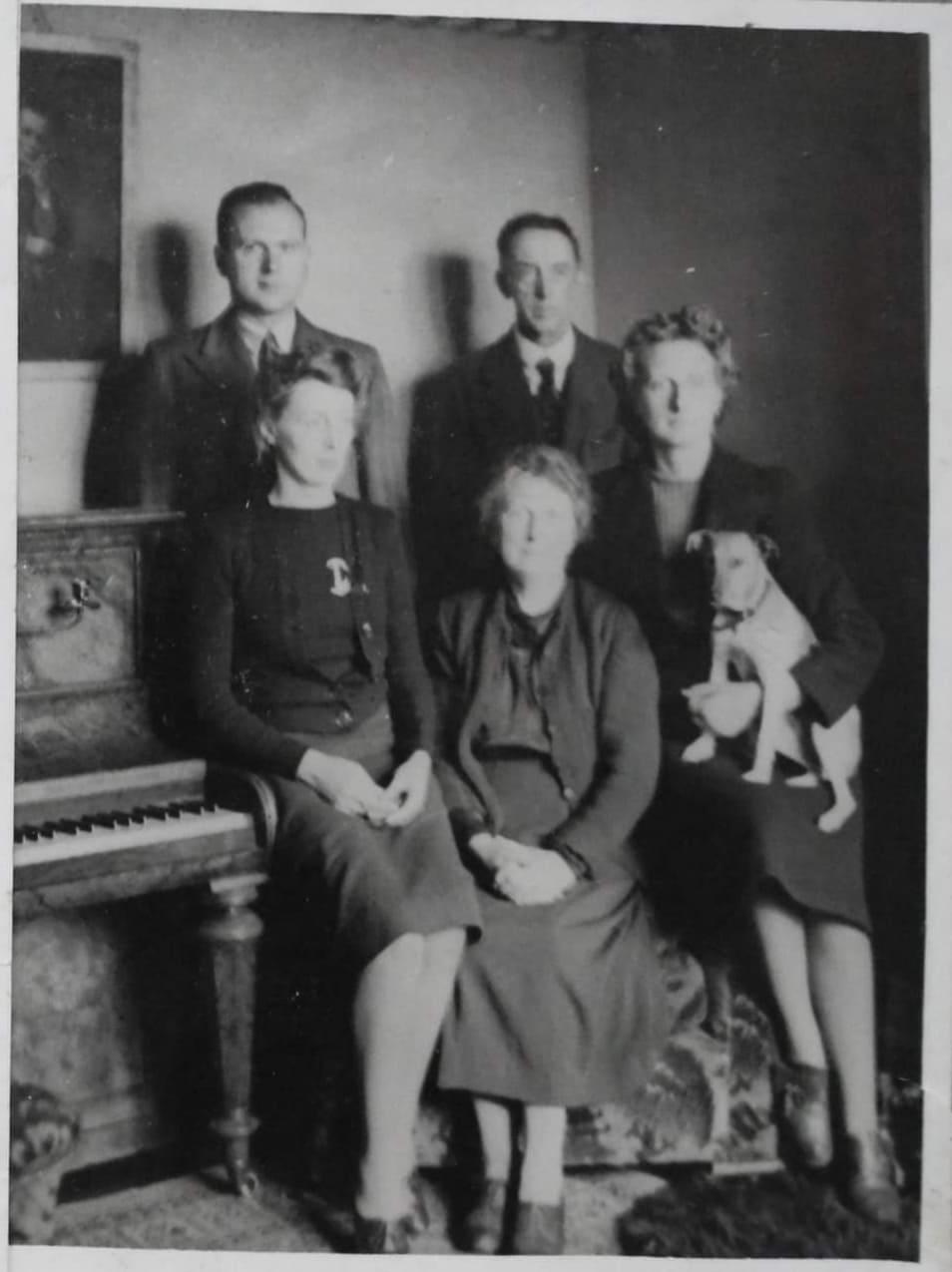
The Search for Samuel Housley
As soon as the search for Catherine Housley’s mother was resolved, achieved by ordering a paper copy of her birth certificate, the search for Catherine Housley’s father commenced. We know he was born in Smalley in 1816, son of William Housley and Ellen Carrington, and that he married Elizabeth Brookes in Wolverhampton in 1844. He was a plumber and glazier. His three daughters born between 1845 and 1849 were born in Smalley. Elizabeth died in 1849 of consumption, but Samuel didn’t register her death. A 20 year old neighbour called Aaron Wadkinson did.

Where was Samuel?
On the 1851 census, two of Samuel’s daughters were listed as inmates in the Belper Workhouse, and the third, 2 year old Catherine, was listed as living with John Benniston and his family in nearby Heanor. Benniston was a framework knitter.
Where was Samuel?
A long search through the microfiche workhouse registers provided an answer. The reason for Elizabeth and Mary Anne’s admission in June 1850 was given as “father in prison”. In May 1850, Samuel Housley was sentenced to one month hard labour at Derby Gaol for failing to maintain his three children. What happened to those little girls in the year after their mothers death, before their father was sentenced, and they entered the workhouse? Where did Catherine go, a six week old baby? We have yet to find out.
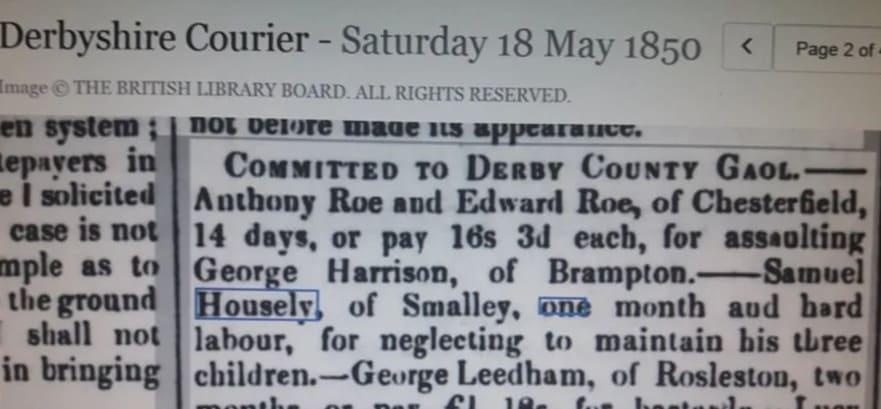
And where was Samuel Housley in 1851? He hasn’t appeared on any census.
According to the Belper workhouse registers, Mary Anne was discharged on trial as a servant February 1860. She was readmitted a month later in March 1860, the reason given: unwell.
Belper Workhouse:
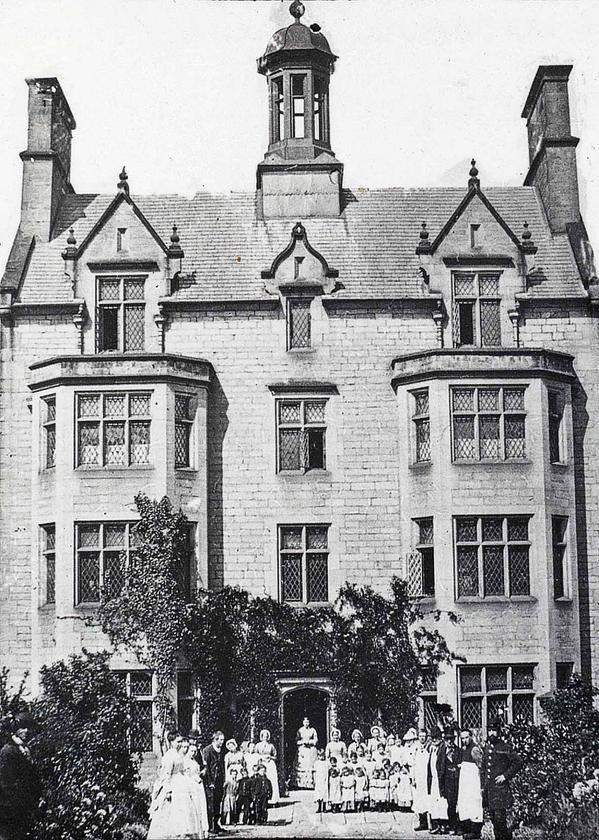
Eventually, Mary Anne and Elizabeth were discharged, in April 1860, with an aunt and uncle. The workhouse register doesn’t name the aunt and uncle. One can only wonder why it took them so long.
On the 1861 census, Elizabeth, 16 years old, is a servant in St Peters, Derby, and Mary Anne, 15 years old, is a servant in St Werburghs, Derby.But where was Samuel?
After some considerable searching, we found him, despite a mistranscription of his name, on the 1861 census, living as a lodger and plumber in Darlaston, Walsall.
Eventually we found him on a 1871 census living as a lodger at the George and Dragon in Henley in Arden. The age is not exactly right, but close enough, he is listed as an unmarried painter, also close enough, and his birth is listed as Kidsley, Derbyshire. He was born at Kidsley Grange Farm. We can assume that he was probably alive in 1872, the year his mother died, and the following year, 1873, during the Kerry vs Housley court case.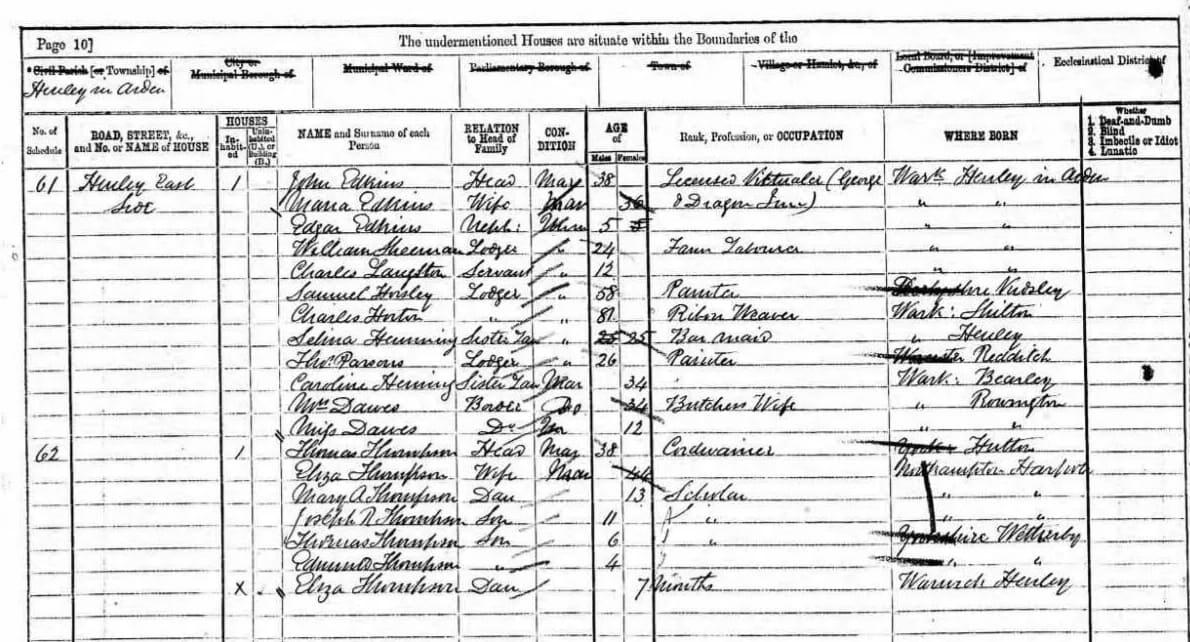
I found some living Housley descendants in USA. Samuel Housley’s brother George emigrated there in 1851. The Housley’s in USA found letters in the attic, from the family in Smalley ~ written between 1851 and 1870s. They sent me a “Narrative on the Letters” with many letter excerpts.
The Housley family were embroiled in a complicated will and court case in the early 1870s. In December 15, 1872, Joseph (Samuel’s brother) wrote to George:
“I think we have now found all out now that is concerned in the matter for there was only Sam that we did not know his whereabouts but I was informed a week ago that he is dead–died about three years ago in Birmingham Union. Poor Sam. He ought to have come to a better end than that….His daughter and her husband went to Birmingham and also to Sutton Coldfield that is where he married his wife from and found out his wife’s brother. It appears he has been there and at Birmingham ever since he went away but ever fond of drink.”
No record of Samuel Housley’s death can be found for the Birmingham Union in 1869 or thereabouts.
But if he was alive in 1871 in Henley In Arden…..
Did Samuel tell his wife’s brother to tell them he was dead? Or did the brothers say he was dead so they could have his share?We still haven’t found a death for Samuel Housley.
January 29, 2020 at 4:21 am #5660In reply to: Two Aunties au Pair and Their Pert Carouses
Arthur was driving the minivan. It was an old Chewy Express van with the big bold “DRAPES CLEANING” sign on it that he’d repainted by himself over the years. The business wasn’t doing great, truth be told, so he’d cut down the marketing costs, which according to Ella Marie wasn’t a bright idea. “You never know where you next patrons could hide.” She’d said, and then had him hooked up on some social website to post random things and get some likes and thumbs up. He’d come a little late for the new century’s game and couldn’t see any of the appeal, but he’d learned over the years never to make the missus irate.
He’d been so glad when she’d come back from the floods, unscathed and full of completely batshit crazy stories. Mummies and stuff. Sounded like being rolled in shredded drapes fanfiction to him. Complete garbage, but you can’t tell people they’re crazy, they’d hate you for it, and in truth you may be wrong. You might be the one crazy and all the others the sane ones. How’s that for a thought.
Anyway, he loved his Ella Marie dearly, and had learned not to sweat the small stuff. Like this night drive to a funny place she’d just received coordinates from an acquaintance on the Net. Those were mad times, mad times indeed. At least, she could have told him she wanted to catch a new rare pokemeon go! in the dead of night, and it might have sounded… well, just as mad probably.
They were driving steadily, being careful about the road signs; the van wasn’t much for crazy stunts anyway.
“How far is that?” he asked the wife, who was busy on her phone tracking the route and chatting on the thing with her friends imaginary or else.
“Not far, luv’. Next turn right, then left, then right and we should be there.”
The last turn took them off the road, and Arthur started to wonder if that wasn’t another “turn left at your peril” GPS experiment, where they’d have to haul the van out of a tar pit, but it seemed fine so far. The place looked ominous, and full of croaking noises 🐸🐸🐸🐸.
He killed the headlights, and moved in the parking lot at a crawl. There was no point in alerting whoever was there of their nocturnal visit. A barn owl flew straight in front of the van, scaring them.
“STOP!” jumped Jacqui, who’d been sleeping the whole time, and woke up to a frightful sight.
Arthur pushed on the brakes that gave off a screeching sound that would wake up a mummy.
“Ooh, I’ve got a bad feeling about this” Ella Marie said. “Something evil is afoot, that owl was bad omen.”
January 29, 2020 at 3:57 am #5659In reply to: The Precious Life and Rambles of Liz Tattler
“You know, I wasn’t initially fond of this idea, Godfrey” Elizabeth said, while looking at Roberto doing the dishes. A bit unusual of her to spend time in the kitchen, probably her least favourite room in the house, but she was keen to revise her judgment as the view was never as entertaining.
Godfrey was finishing a goblet full of cashews while leafing through the “Plot like it’s hot” new book from the publishing house that Bronkel had sent autographed and dedicated to Liz “without whom this book may have never seen the light of day”.
“Godfrey, are you listening to me? You can’t be distracted when I talk to you, I may say something important, and don’t count on me to remember it afterwards. Besides, what’s with the cashews anyway?”
“Oh, I read they’re good natural anti-depressant… Anyway, you were saying?”
“You see, like I just said, you made me lose my stream of thought! And no… the view is for nothing in that.” She winked at Roberto who was blissfully unaware of the attention. “Yes! I was saying. About that idea to write Finnley in the new novel. Completely rash, if you’ve had asked before. But now I see the benefit. At least some of it.”
“Wait, what?”
“Why are you never paying attention?”
“No, no, I heard you. But I never… wait a minute.” The pushy ghostwriting ghostediting, and most probably ghostcleaning maid (though never actually seen a proof of that last one) had surely taken some new brazen initiative. Well, at least Liz wasn’t taking it too badly. There maybe even was a good possibility she was trying hard to stay on continuity track about it. Godfrey continued “Benefit, you said?”
“Yes, don’t make me repeat myself, I’ll sound like a daft old person if ever a biopic is made of me, which by the way according to Bronkel is quite a probability. He’s heard it from a screenwriter friend of his, although his speciality is on more racy things, but don’t get me carried away. The benefit you see, and I’ve been reading Bronkel’s stupid book, yes. The benefit is… it moves the plot forward, with ‘but therefore’ instead of ‘and then’. It adds a bit of spice, if you get what I mean. Adds beats into the story. Might be useful for my next whydunit.”
Godfrey was finding her indeed lingering a tad too obviously on the ‘but‘ and their beats, but abstained from saying anything, and nodded silently, his mouth full of the last of the cashews.
Liz pursed her lips “Well, all this literature theory is a great deal of nonsense, you know my stance on it; I made my success without a shred of it…”
“Maybe you’re a natural” Godfrey ventured.
“Maybe… but then, they’ve got some points, although none as profound as Lemone’s. His last one got me pondering: finckleways is not a way in, delete it or it’ll get you locked out; only flove exists now. “
January 18, 2020 at 8:18 am #5611In reply to: The Precious Life and Rambles of Liz Tattler
“I have nothing against outrageous clothes,” Liz said, feeling the unspoken murmurs of “we noticed” from the others. She smoothed down the voluminous pink satin of her floor length gown, batting her false eyelashes. “Life is one long fancy dress party, and one should dress accordingly. Today I am Barbara Tartland,” Liz flashed her long pink nails. “Otherwise known as the Pink Thing.”
Godfrey replied with some alarm, “You’re not planning on writing soppy romances are you, all with identical plots and predictable characters?”
“Why Godfrey, I thought you’d be pleased,” Liz said. “You know how they fly off the shelves.”
“That’s because the characters are trying to commit suicide,” said Finnley.
December 25, 2019 at 7:59 am #4954In reply to: The Chronicles of the Flying Fish Inn
Aunt Idle:
Bert tells me it’s Christmas day today. Christmas! I just looked at him blankly when he told me, trying to bring to mind what it used to be like. I can’t remember the last time Christmas was normal. Probably around fifteen years ago, just before the six years of fires started. It’s a wonder we survived, but we did. Even Mater. God knows how old she is now, maybe Bert knows. He’s the one trying to keep track of the passing of time. I don’t know what for, he’s well past his sell by date, but seems to cling on no matter what, like Mater. And me I suppose.
We lost contact with the outside world over ten years ago (so Bert tells me, I wouldn’t know how long it was). It was all very strange at first but it’s amazing what you can get used to. Once you get over expecting it to go back to normal, that is. It took us a long time to give up on the idea of going back to normal. But once you do, it changes your perspective.
But don’t get me wrong, it hasn’t been all bad. We haven’t heard anything of the twins, not for a good ten years or more (you’d have to ask Bert how long) but I hear their voices in my head sometimes, and dream of them. In my dreams they’re always on the water, on a big flat raft boat. I love it when I dream of them and see all that water. Don’t ask me how, but I know they’re alright.
Anyway like I said, it hasn’t been all bad. Vulture meat is pretty tasty if you cook it well. The vultures did alright with it all, the sky was black with them at times, right after the droughts and the fires. But we don’t eat much these days, funny how you get used to that, too. We grow mushrooms down in the old mines (Bert’s idea, I don’t know what we’d do without him). And when the rains came, they were plentiful. More rain than we’d ever seen here.
Well I could go on, but like I said, it’s Christmas day according to Bert. I intend to sit on the porch and try and bring Prune and Devan and the twins to mind and see if I can send them a message.
Prune’s been back to see us once (you’d have to ask Bert when it was). She was on some kind of land sailing contraption, no good asking me what was powering the thing, there’s been no normal fuel for a good long time, none that’s come our way. Any time anyone comes (which is seldom) they come on camels or horses. One young family came passing through on a cart pulled by a cow once. But Prune came wafting in on some clever thing I’d never seen the likes of before. She didn’t stay long, she was going back to China, she said. It was all very different there, she said. Not all back to the dark ages like here, that’s what she said. But then, we were here in the first place because we liked a quiet simple life. Weren’t we? Hard to remember.
July 8, 2019 at 7:50 pm #4632In reply to: Seven Twines and the Dragon Heartwoods
Sometimes, you have to go underground to uncover the truth.
Rukshan thought it meant taking the new underground carts once only.
Frankly, he’d preferred to travel through the familiar Shadow Maps, the ones Dark Faes like him could draw, that would give them access to a secret parallel world of mist and phantoms, shadows and secrets. It was the true world the Faes originated from, long ago, in a time before history.
It wasn’t used much nowadays, most Centenial Faes having lost the capacity, or the interest in the place, leaving only bitter unsavoury people creeping there, spying on secrets, and trading in for favours, while being too afraid to leave the known parallel world, too afraid that if they left it, they’d lose the way back.
For Rukshan and a few in the Queen’s lineage, the place was still more or less of a familiar dwelling, a winter residence of sorts, for when solace and retreat was required.Only the Shadow Maps weren’t safe any longer, something had crept along the lay lines and was lurking at every corner, keeping guard at most of the known entrances and reporting to some unknown power.
Few moons back, Rukshan was still meditating in the Shadow world, not very far from the work at the cottage, which he could hear at times through the thin dimensional walls, when he came across Konrad. Konrad, another Fae from the Old Houses, one with a heavy secret. “I’ve hidden her from him” he told him in short broken sentences. “His daughter, Nesingwarys, she is hidden for now, but He’ll be looking for her, once He recovers, and she won’t be safe. He can’t find her, I have to protect her, she holds power to bring his reign of terror back.”
Truly, it didn’t make a lot of sense, but it had picked his curiosity. Rukshan left the other Fae to his apparent madness, but wondered about the coincidence. That Garl, the name Konrad gave to the dark fallen monarch, according to what he could piece together, seemed to have been vanquished or disappeared about the same time they’d all managed to repel the Shadow in the Forest.
He would usually have left it at that, but then, a few days later, started to realize something was wrong in the Shadow world, and that this very something was growing.
“And now, I’m stuck in an underground cart crammed full of people to go to the city. And they call that progress…”
A bearded guy smelling of piss and wine, was doing acrobatics with his crutches and what was left of his left leg. He was looking at people with a half-toothed grin and a blissful face while muttering things Rukshan couldn’t figure. His face reminded him of a thespian he’d known. Rukshan couldn’t shake the feeling there was message in that. When the underground cart dinged to announce the Grand Belfrey Station, Rukshan was relieved to finally be out for fresh air. Magnificent craftsmanship he would say to the gnomes in charge of the tunnels, but really, underground cart wasn’t his thing.
April 18, 2018 at 12:56 pm #4455In reply to: The Precious Life and Rambles of Liz Tattler
The biggest shock of all was finding the unposted draft comment under the random rewreights story, but what on earth was it all about?
“Interestingly such bodies alone while the heads cling to — when they felt the desire for movement, that is.
At least, that’s what the Forehead was thinking while shaving — as it did not have enough appendages to be able to meditate while defecating, which was by far, it was told, the best method of enlightenment known to Peasmen and other sensible beings.
Anyway, how odder can it be, it thought again. It may well be time to shift all of this a bit — why would each head need such a renewal of bodies and thus incarnations (or more properly, “embodiments”) without itself changing. Funnily enough, the alien bodies had in fact no need for heads. They actually had more than one: one for each of the sensory tendrils coming out of their shoulders. And according to them, Peasland bodies could very well start their ®evolution just now.
alone were reproducing while the heads had to constantly find out new bodies to cling to — when they felt the desire for movement, that is.At least, that’s what the Forehead was thinking while shaving — as it did not have enough appendages to be able to meditate while defecating, which was by far, it was told, the best method of enlightenment known to Peasmen and other sensible beings.
Anyway, how odder can it be, it thought again. It may well be time to shift all of this a bit — why would each head need such a renewal of bodies and thus incarnations (or more properly, “embodiments”) without itself changing. Funnily enough, the alien bodies had in fact no need for heads. They actually had more than one: one for each of the sensory tendrils coming out of their shoulders. And according to them, Peasland bodies could very well start their ®evolution just now.”Liz was baffled, and decided to go and sit in the sun and think about it and see if any of this had helped, before continuing.
June 3, 2017 at 5:47 am #4343In reply to: Seven Twines and the Dragon Heartwoods
“I had another vivid dream last night, Sunny. I dreamed of a man I met when i was selling my potions in the market place in town. He was chasing a little red fox and I gave him some potion … “
“You dreamed of a fox? That’s a very good omen and fortuitously also reminds me of a joke.
What do you call a fox with a carrot in each ear?
Anything you want as he can’t hear you!”Glynis smiled reluctantly.
“No, that’s what happened. I’ve not got to the dream part yet.”
“My apologies,” said Sunny, nudging her ear gently from his perch on her shoulder. “Please continue.”
“Anyway the man from the market came to me in my dream and thanked me. He said his wife was well now. He said to look for a gift in the heartwoods.”
“Excellent dream!” said Sunny. “I adore gifts. I will keep my eyes open and hope we find it poste haste. How much further is it now, anyway?”
“Another few days travel to the fringe of the heartwoods. According to the map, that’s where the first X is.”
They continued in silence, glad of each other’s company on the journey.
Glynis had been sad to leave the Bakers and more than a few tears were shed on parting They tried to get her to stay but it was without much conviction for Glynis had shown them the map and, though plain folk, they had sound instincts and knew when something had to be.
“Any time you want, Girl,” said Mr Baker gruffly, “you’ll find a home here. You hear me? And make sure you keep in touch.”
And Glynis nodded, unable to find the words to thank him for his kindness.
And Mrs Baker had made her a new burka. She’d stayed up nights sewing to surprise Glynnis. It shimmered, sometimes green and sometimes blue depending on where the light fell and it felt like silk to the touch. Glynis thought it was the most pretty thing she had ever seen.
“You’ve a lovely heart, Lass, and anyone who’s worth a penny will see that and not those scales on your face.”
It was the first time either of the Bakers had mentioned her appearance and for a moment Glynis was rendered speechless.
But not so, Sunny.
“Knock, knock!” he cackled loudly. “Oh come on! It’s a good one!”
“Who’s there?” said Glynis softly.
“Dragon!”
“Dragon who?”
“Dragon your feet again?”January 15, 2017 at 4:00 am #4275In reply to: Seven Twines and the Dragon Heartwoods
There was no way around it. As hard as he would have tried, he couldn’t reach the peaks of the mountain without crossing the part of the Enchanted Forest which the Fae called their own. There was no way for him to avoid paying the price, or to avoid facing the Court.
Rukshan wished there was an easier way, but trying to avoid it would only delay the inevitable. Besides, he would need provisions to continue his journey —that is, if they’d let him.The first signs of the enchanted signposts had appeared two days ago. He’d been walking through the silent and cold forest for close to ten days already. His progress was slow, as the days were short, and the nights were better spent recuperating.
The early signs that he was approaching the Fae land wouldn’t have been noticeable by any other than those with some Fae blood in their veins. Some were as subtle as enchanted dewdrops on spiderwebs, other few were watcher crows, but most of the others were simply sapling trees, shaking at the slightest change of wind. All of them silent watchers of the Forest, spies for the Queen and her Court.From the first sign, he had three days. Three days to declare himself, or face the consequences. He would wait for the last one. There was something magical about the number three, and anything more hasty would only mean he was guilty of something.
Like improper use of magic he thought, smiling at the memory of the oiliphant. The Queen was clutching at a dwindling empire, and magic sources gone scarce meant it had to be “properly” used.
He never believed such nonsense, which is why he’d decided to live outside of their traditions. But for all his disagreement, he remained one of them, bound by the same natural laws, and the same particularities. Meant to reach extremely old ages while keeping an external appearance as youthful as will is strong in their mind, able to wield strong magic according to one’s dispositions, ever bound to tell the truth (and becoming thus exceptionally crafty at deception), and a visceral distaste for the Bane, iron in all its forms.
Thus was his heritage, the one he shared with the family that was now waiting for his sign to be granted an audience in the Court.One more day, he thought…
January 14, 2017 at 9:25 pm #4274In reply to: Seven Twines and the Dragon Heartwoods
“More bones?” asked Yorath, smiling, as Eleri caught up with him on the forest path.
“I ask you, why is it,” she asked, leaning against a tree to catch her breath, “Why is it that we collect bones to make a complete one, but never go back to the same place for bones?”
Yorath paused and turned, raising an eyebrow.
“Never mind, don’t answer that, that’s not what I’m getting at ~ not now anyway ~ I just remembered something, Yorath.”
He waited expectantly for her to continue, but she didn’t reply. He mouth had dropped open as she gazed vacantly into the middle distance, slightly cross eyed and wonder struck.
“You were saying?” he prompted gently.
Her attention returned and she grabbed his arm and pointed down towards the lowlands. “Look! Down there,” she said, giving his elbow a shake. “It was down there when I was a child and it was that one day in spring and I saw it. I know I did. They all said I read the story first and then imagined it, but it was the other way round.” Noticing her friends unspoken suggestion that she slow down and clarify, Eleri paused and took a few deep breaths.
“I’d sort of half forgotten about it,” Eleri laughed. “But suddenly it all makes sense. There is a legend,” she explained, “that on one day of the year in spring all the things that were turned to stone to hide them came to life, just for the day. One of my earliest memories, we were out for a picnic in the hills on the other side of the valley and everyone had fallen asleep on rugs on the grass, and I wandered off. I was four years old, maybe five. You know when you see a rock that looks like a face, or a tree that looks like an animal or a person? Well on this one day of the year, according to the legend, they all come back to life ~ even the clouds that look like whales and birds. And it’s true, you see, Yorath. Because I’ve seen it.”
“I’ve heard of it, and the tree that guards it all comes to life, did you see her?”
“Yes. And she said something to me, but I don’t remember what the words were. I knew she said something, but I didn’t know what.”
January 6, 2017 at 7:06 am #4272In reply to: Seven Twines and the Dragon Heartwoods
Kumihimo was rummaging through the content of a wooden chest at the back of the cave. According to the smell it had spent too much time in the dark and humid environment. She might have to do some spring cleaning one day. But the chest was now too heavy for her to carry. I need an apprentice for this, she thought not knowing if if was a wish or a regret.
In that chest, she had her many tools of the thread. Some were made of bones and she had carved them herself under the direction of her spirit guides. Each one had a specific purpose, either to catch, to extract, to guide, or to dissipate, and many more usages that even she had forgotten after so many years spent in that place.
She had accumulated so many things in that chest. Fortunately she liked miniature, and most of her creations were seldom bigger than her little finger. However that made it difficult to keep things in order and finding something was often a real challenge. So she sang lullabies to lure the object she was looking for out of their sanctuary.
Victory! she exulted in the ancient tongue, which would translate also as ‘I have done all that is necessary to harvest the benefits of the next crop’. Kumihimo liked simple things and she liked when one word could signify a very complex meaning. Under an old donkey skin that she often used to camouflage herself when she was going down in the valley, she had found the loom she had been looking for.
The loom was made from the right shoulder blade of a bear. It was one of the first objects she had carved when she arrived in the vicinity. It had a yellowish patina and felt very smooth in her hands. Its shape was octagonal and each side had seven notches under which were three rows of symbols, some of the ink was gone after so many years, but she could still feel the groove where she had carved them. She smiled at the fond memories and at the dear friend who allowed her to take his bone when he died of old age.
In the centre of the loom was a heart with a circular hole in it. It was where the braid would emerge.Holding the precious object, Kumihimo could feel all the braids she had already made and all the potential braids that waited to come into existence. She felt warmth bloom in her heart at the task at hand.
Each notch corresponded at the same time to a time of the year, to a direction on earth and in the sky, and some rather obscure references to many other phenomenon and concepts. The weaving depended on very complex rules that she had discovered from experience. Actually the meaning weaved itself into the braid through a subtle interaction between her and Spirit. That way she didn’t have to bother about what to do or what notch to use as it would all unfold during the weaving.
She stood up and walked outside. The day was still young and she had a lot to do. The weaving ceremony was an act of spontaneity, but it required some preparation. She put the loom on a round rock to dry in the Sun and went to examine the hanging threads. She had to choose carefully.
January 4, 2017 at 6:19 am #4268In reply to: Seven Twines and the Dragon Heartwoods
The seven little spheres had each a different colour. Gorrash looked at them with envy in his heart. He’d rarely seen colours as his life was mostly at night, under the moonlight or under the yellow tint of candles and gas lamps. However, the spheres had their own light from inside. And Gorrash couldn’t touch them as Rainbow was very protective, and it made the stone dwarf restless. He had tried once to take one sphere and he got a warning slap on his hand. Rainbow looked soft and gentle, but a whip is always soft and supple before it struck.
The whole week they had been on the hunt for all kind of potions from the shelves of the dragon woman. Glynis, she had called herself during one of her monologues in front of the mirror. Her sadness and frustration toward her appearance resonated more than once with his own condition. He had felt guilty about their little thefts, but he had soon realised that nothing would stop Rainbow.
The randomness of the creature’s choice of potions appeared to be not so random. Gorrash tried several times to help, picking up potions for his friend, according to the colours he liked or to the shapes of the phials that intrigued him, but the creature refused many times the offering.
The colours mattered to Rainbow, apparently. It would never take black, Gorrash discovered. Only colours from the rainbow spectrum, a voice said inside him. He had learned to recognised it as the voice of his creator’s memories infused into the core of his matter. One thing he wasn’t sure though was about the process of his birth. Has he been carved out from a stone ? Has he been assembled like clay ? That was not part of the memories trapped into his stone body.
Gorrash then tried to bring the creature colours from the rainbow, always glowing, never dull or matte. But then he discovered it had to be in a certain order. Everyday was different. One day it was in the order of the colour spectrum from red to purple, as his master’s remembered. Another day it had to begin with green or indigo. But always following the order of the colour wheel. If a colour was missing, then they had to wait until Glynis would manufacture it.
And then, one day… one night, as Gorrash woke up from his rigid sleep, the seven spheres were there, and Rainbow was watching over them. Like a bird over its eggs, said the voice. Except they didn’t really look like eggs. Eggs don’t glow with different colours. Eggs have a shell. Those were translucent, glowing of some very attractive inner light, and looked like water spheres. Does that mean it’s a she? wondered Gorrash who had always thought his friend was a male. He gnawed at his lower lip. Anyway, it seemed that the hunting days were over as Rainbow didn’t show any motivation to leave her strange progeny, and Gorrash had no way to go past the walls on his own.
Rainbow raised its eyebrows and looked at the dwarf who had come too close to the eggs for its taste. It gathered protectively the spheres which came as one in a big multicoloured moving spheroid. Gorrash could still see the individual light cores in it, they seemed to pulse like the growing desire in his heart. He swallowed. It tasted of dust.
— I won’t take them, he said.
His chest tightened as he saw suspicion in his friend’s eyes. Gorrash turned away feeling sadness and guilt. He needed to find some distraction from the attractive lights and the growing desire in his heart.
March 12, 2016 at 5:51 pm #4003In reply to: The Precious Life and Rambles of Liz Tattler
“You rang, madam?” asked the butler, adjusting his oversized blue turban.
“Ah, Lazuli! How are you settling in?” asked Liz.
“I’ve only just been written into this thread, madam, moments ago. Do I have to call you madam?”
“Only when you want to be rude, according to Finnley,” Liz said, glancing fondly at the unconscious cleaner.
“This thread appears to be going nowhere, madam,” Lazuli remarked thoughtfully.
“I can write Fanella into it if you like,” Liz quickly tried to entice him to stay.
Lazuli Galore’s eyes lit up. “Did somebody mention something about sexing the story up a bit?” he asked hopefully. “We’d be the perfect characters for that.”
“Well, if its ok with Finnley, it’s ok with me. If you can wake her, we can ask her now.”
February 22, 2016 at 9:47 am #3943In reply to: Mandala of Ascensions
The jiggong meditation’s end was signaled by a silent ring of the immaterial bell in between states of mind. MJ stretched his ideas and send a shepherd to gather his thoughts. Today only one student connected to the session. MJ acknowledged his presence with a slight flickr of his crown chakra and he checked his voicemail. 1223 messages from Dispersee. He let the potential irritation dissolve as it was born into existence and prepared to respond. No need to listen to the messages, it would only delay the answer.
He felt a nudge from the student who hadn’t dissipated as he should. Some hesitation fluctuated in the energy. He turned his attention to the void and waited. His motto was to always let people ask the questions they had if they had any, and not begin a conversation if you hadn’t something important to say.
Master John ?
MJ sent some encouragement to the void where the student thought he was.
I can’t think of a question, finally expressed the student out of nowhere.
Maybe you don’t have any question, MJ said to the void.
The student’s energy rippled with surprise. Had he been on Earth plane, he would have had a nervous laugh.Master John had already been aware that the void of the student had no question but was filled with interrogations. He was desperately trying to find something to ask in need to connect, unaware that the connection already existed and required no movement.
MJ sent an energy egg to the student. Let him play with that. It was crafted according to the ancient Chinese culture and hard to crack. With lots of mind knots and shiny curly clues. MJ let his pride of having created the object dissolve like squid ink in the ocean of his mind.Suddenly absorbed by the illusory complexity of the egg, the student suddenly blended into the void of MJ’s mind, replaced by the myriads of Dispersee’s messages cackling simutaneously to catch his unwavering attention. He picked one of them and followed the thread to Dispersee and to a nice pique nique in the mountain apparently. Floverly was already there, sitting on a patch of red flowers.
You could have changed after your jiggong, she said.
September 29, 2015 at 1:11 am #3790In reply to: The Hosts of Mars
For all her wired cleverness, there was something that the central intelligence had seemingly forgotten to take into account in her parameters.
Eb woke up in a sweat, barely remembering bits of a horrible dream of being chased and banging on a closed door for escape from a herd of phombies (those guys who had their phones implanted under their skins and would often have a creepy vacant look while in communication).
The banging on the door. According to his mother, if there was something that her nurse Fancy Woo was better at than cooking rice, it was at interpreting dreams. But he didn’t need her expert advice on this one.
His mind was aching from the lack of alcohol, but at least he could think quite clearly.
There weren’t many accesses to enter the simulation, for obvious reasons. Continuity had to be maintained at all costs, to preserve the sanctity of the experiment. That motto had survived the multiple iterations of the simulation since its inception.Eb knew of most of them, even if he’d wondered about the presence of backdoors. He had not been able to find any since his many years of service. So for all he knew, there were only two ways to get in and out: up and down. “Up” through the fake ships, with the whole stasis protocol, and “down”, through the mines were they would usually send agents from time to time, mostly for reconnaissance purposes.
He looked at the screen, and as he had feared, the explosion triggered in the tunnels by Finnley had sealed their main exit point.
“You underestimate me, my dear Eb” the voice of Finnley merrily bounced on the insulated walls.
Eb was startled. Hadn’t he known that Finnley was just a program, he could have sworn her synthetic voice had a trace of menace in it.
“Finnley” he regained his composure as much as he could “Haven’t the thought occurred to you that the tunnels are now sealed? We cannot let your blue aliens go in and out as easily now!”
“Eb, you do know I do not think.” Her voice was still slightly ominous. “But I ran multiple simulation, and this one still yields the best possible outcome.” she continued more cheerily.
“How so?”
“It is evident. Many of the earlier settlers, still know about the simulation, even if they self-programmed themselves to accept the illusion as better than outside reality. They can become a problem for the evacuation protocol. With the tunnels’ exit collapsed, they have no other way than to comply. Besides, what good plausible aliens come out from the ground, really. We don’t want to miss their grand entrance.
And don’t be such a worrywort about budget, Eb.”September 7, 2014 at 8:44 pm #3499In reply to: Scrying the Word Cloud
max coffee
smell particular creatures, somehow
butt (silence ~ worry comes) elephant;
myself, understand techromancer needed feelings.
welcome arona! abalone according itself…… -
AuthorSearch Results
Search Results for 'according'
-
Search Results
-
The following stories started with a single question.
Who was Catherine Housley’s mother?
But one question leads to another, and another, and so this book will never be finished. This is the first in a collection of stories of a family history research project, not a complete family history. There will always be more questions and more searches, and each new find presents more questions.
A list of names and dates is only moderately interesting, and doesn’t mean much unless you get to know the characters along the way. For example, a cousin on my fathers side has already done a great deal of thorough and accurate family research. I copied one branch of the family onto my tree, going back to the 1500’s, but lost interest in it after about an hour or so, because I didn’t feel I knew any of the individuals.
Parish registers, the census every ten years, birth, death and marriage certificates can tell you so much, but they can’t tell you why. They don’t tell you why parents chose the names they did for their children, or why they moved, or why they married in another town. They don’t tell you why a person lived in another household, or for how long. The census every ten years doesn’t tell you what people were doing in the intervening years, and in the case of the UK and the hundred year privacy rule, we can’t even use those for the past century. The first census was in 1831 in England, prior to that all we have are parish registers. An astonishing amount of them have survived and have been transcribed and are one way or another available to see, both transcriptions and microfiche images. Not all of them survived, however. Sometimes the writing has faded to white, sometimes pages are missing, and in some case the entire register is lost or damaged.
Sometimes if you are lucky, you may find mention of an ancestor in an obscure little local history book or a journal or diary. Wills, court cases, and newspaper archives often provide interesting information. Town memories and history groups on social media are another excellent source of information, from old photographs of the area, old maps, local history, and of course, distantly related relatives still living in the area. Local history societies can be useful, and some if not all are very helpful.
If you’re very lucky indeed, you might find a distant relative in another country whose grandparents saved and transcribed bundles of old letters found in the attic, from the family in England to the brother who emigrated, written in the 1800s. More on this later, as it merits its own chapter as the most exciting find so far.
The social history of the time and place is important and provides many clues as to why people moved and why the family professions and occupations changed over generations. The Enclosures Act and the Industrial Revolution in England created difficulties for rural farmers, factories replaced cottage industries, and the sons of land owning farmers became shop keepers and miners in the local towns. For the most part (at least in my own research) people didn’t move around much unless there was a reason. There are no reasons mentioned in the various registers, records and documents, but with a little reading of social history you can sometimes make a good guess. Samuel Housley, for example, a plumber, probably moved from rural Derbyshire to urban Wolverhampton, when there was a big project to install indoor plumbing to areas of the city in the early 1800s. Derbyshire nailmakers were offered a job and a house if they moved to Wolverhampton a generation earlier.
Occasionally a couple would marry in another parish, although usually they married in their own. Again, there was often a reason. William Housley and Ellen Carrington married in Ashbourne, not in Smalley. In this case, William’s first wife was Mary Carrington, Ellen’s sister. It was not uncommon for a man to marry a deceased wife’s sister, but it wasn’t strictly speaking legal. This caused some problems later when William died, as the children of the first wife contested the will, on the grounds of the second marriage being illegal.
Needless to say, there are always questions remaining, and often a fresh pair of eyes can help find a vital piece of information that has escaped you. In one case, I’d been looking for the death of a widow, Mary Anne Gilman, and had failed to notice that she remarried at a late age. Her death was easy to find, once I searched for it with her second husbands name.
This brings me to the topic of maternal family lines. One tends to think of their lineage with the focus on paternal surnames, but very quickly the number of surnames increases, and all of the maternal lines are directly related as much as the paternal name. This is of course obvious, if you start from the beginning with yourself and work back. In other words, there is not much point in simply looking for your fathers name hundreds of years ago because there are hundreds of other names that are equally your own family ancestors. And in my case, although not intentionally, I’ve investigated far more maternal lines than paternal.
This book, which I hope will be the first of several, will concentrate on my mothers family: The story so far that started with the portrait of Catherine Housley’s mother.

This painting, now in my mothers house, used to hang over the piano in the home of her grandparents. It says on the back “Catherine Housley’s mother, Smalley”.
The portrait of Catherine Housley’s mother can be seen above the piano. Back row Ronald Marshall, my grandfathers brother, William Marshall, my great grandfather, Mary Ann Gilman Purdy Marshall in the middle, my great grandmother, with her daughters Dorothy on the left and Phyllis on the right, at the Marshall’s house on Love Lane in Stourbridge.

The Search for Samuel Housley
As soon as the search for Catherine Housley’s mother was resolved, achieved by ordering a paper copy of her birth certificate, the search for Catherine Housley’s father commenced. We know he was born in Smalley in 1816, son of William Housley and Ellen Carrington, and that he married Elizabeth Brookes in Wolverhampton in 1844. He was a plumber and glazier. His three daughters born between 1845 and 1849 were born in Smalley. Elizabeth died in 1849 of consumption, but Samuel didn’t register her death. A 20 year old neighbour called Aaron Wadkinson did.

Where was Samuel?
On the 1851 census, two of Samuel’s daughters were listed as inmates in the Belper Workhouse, and the third, 2 year old Catherine, was listed as living with John Benniston and his family in nearby Heanor. Benniston was a framework knitter.
Where was Samuel?
A long search through the microfiche workhouse registers provided an answer. The reason for Elizabeth and Mary Anne’s admission in June 1850 was given as “father in prison”. In May 1850, Samuel Housley was sentenced to one month hard labour at Derby Gaol for failing to maintain his three children. What happened to those little girls in the year after their mothers death, before their father was sentenced, and they entered the workhouse? Where did Catherine go, a six week old baby? We have yet to find out.

And where was Samuel Housley in 1851? He hasn’t appeared on any census.
According to the Belper workhouse registers, Mary Anne was discharged on trial as a servant February 1860. She was readmitted a month later in March 1860, the reason given: unwell.
Belper Workhouse:

Eventually, Mary Anne and Elizabeth were discharged, in April 1860, with an aunt and uncle. The workhouse register doesn’t name the aunt and uncle. One can only wonder why it took them so long.
On the 1861 census, Elizabeth, 16 years old, is a servant in St Peters, Derby, and Mary Anne, 15 years old, is a servant in St Werburghs, Derby.But where was Samuel?
After some considerable searching, we found him, despite a mistranscription of his name, on the 1861 census, living as a lodger and plumber in Darlaston, Walsall.
Eventually we found him on a 1871 census living as a lodger at the George and Dragon in Henley in Arden. The age is not exactly right, but close enough, he is listed as an unmarried painter, also close enough, and his birth is listed as Kidsley, Derbyshire. He was born at Kidsley Grange Farm. We can assume that he was probably alive in 1872, the year his mother died, and the following year, 1873, during the Kerry vs Housley court case.
I found some living Housley descendants in USA. Samuel Housley’s brother George emigrated there in 1851. The Housley’s in USA found letters in the attic, from the family in Smalley ~ written between 1851 and 1870s. They sent me a “Narrative on the Letters” with many letter excerpts.
The Housley family were embroiled in a complicated will and court case in the early 1870s. In December 15, 1872, Joseph (Samuel’s brother) wrote to George:
“I think we have now found all out now that is concerned in the matter for there was only Sam that we did not know his whereabouts but I was informed a week ago that he is dead–died about three years ago in Birmingham Union. Poor Sam. He ought to have come to a better end than that….His daughter and her husband went to Birmingham and also to Sutton Coldfield that is where he married his wife from and found out his wife’s brother. It appears he has been there and at Birmingham ever since he went away but ever fond of drink.”
No record of Samuel Housley’s death can be found for the Birmingham Union in 1869 or thereabouts.
But if he was alive in 1871 in Henley In Arden…..
Did Samuel tell his wife’s brother to tell them he was dead? Or did the brothers say he was dead so they could have his share?We still haven’t found a death for Samuel Housley.